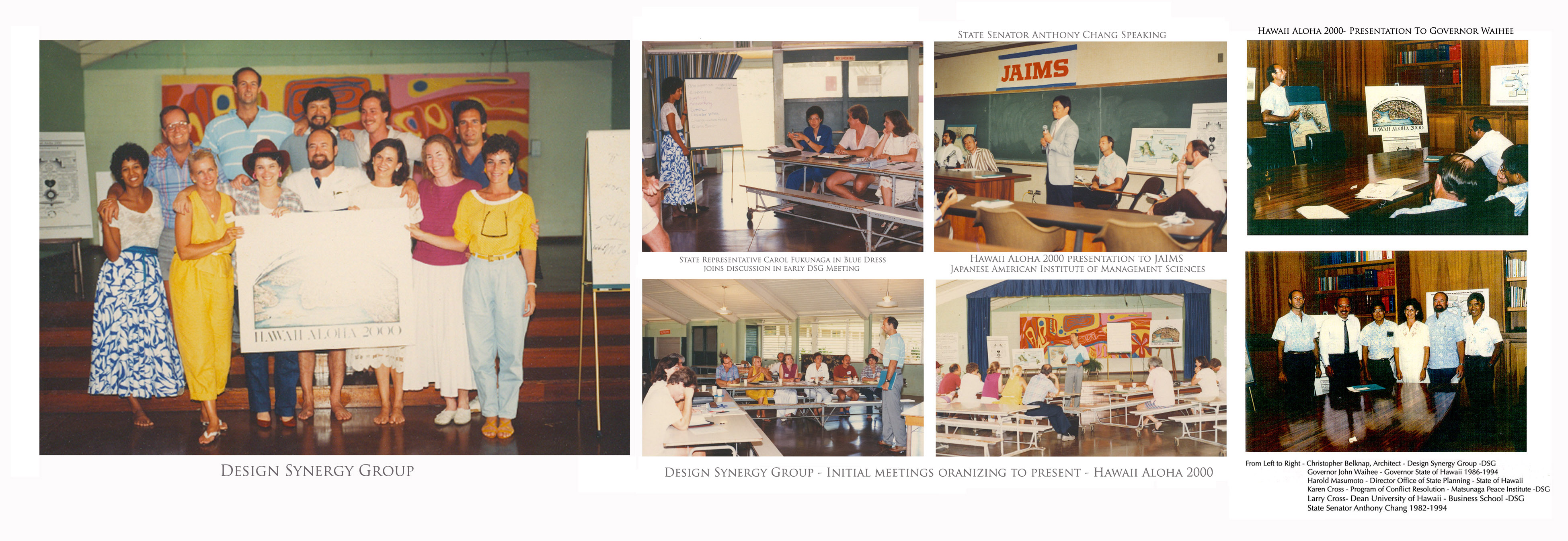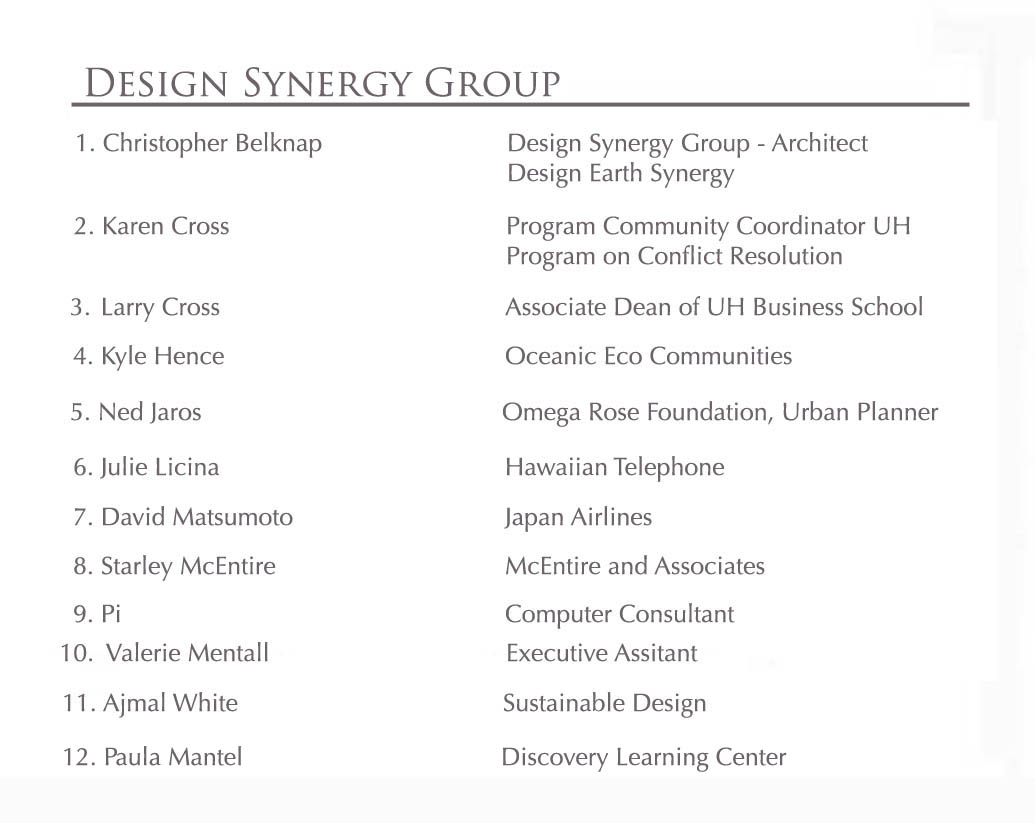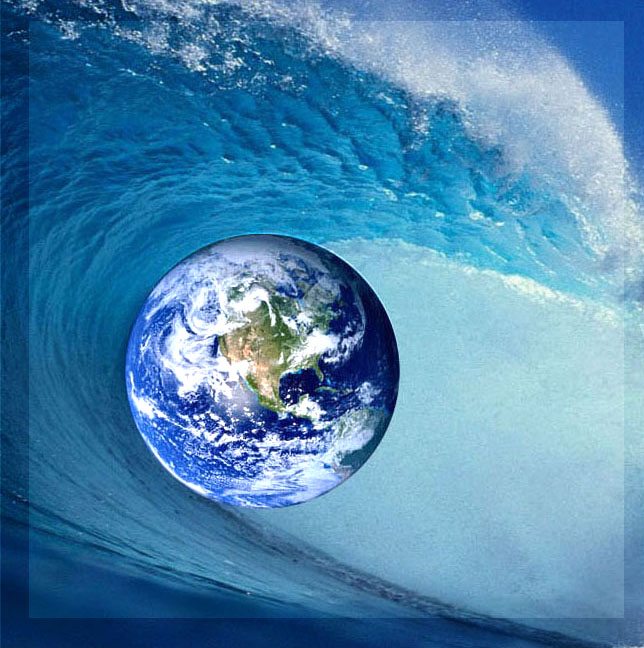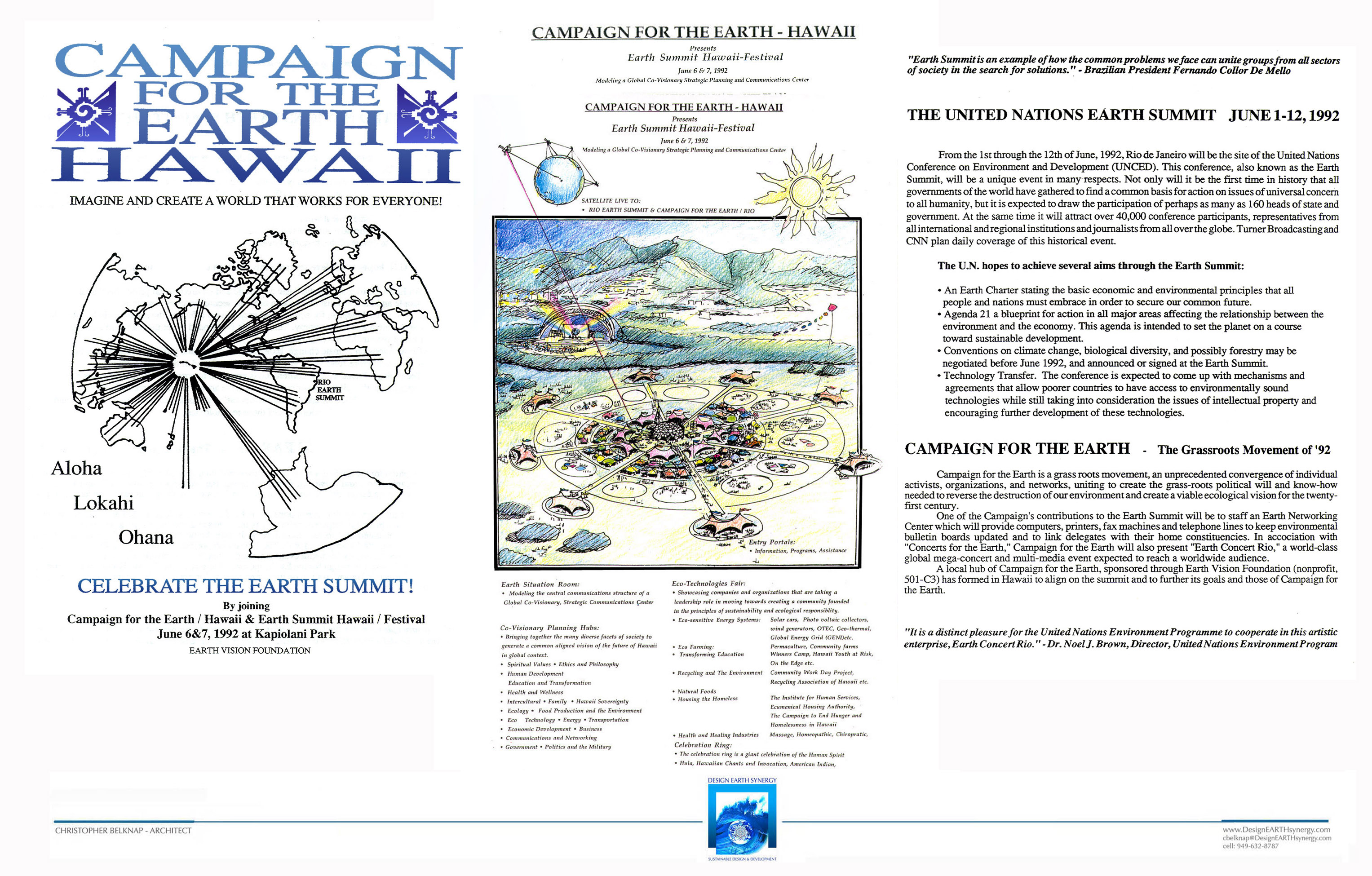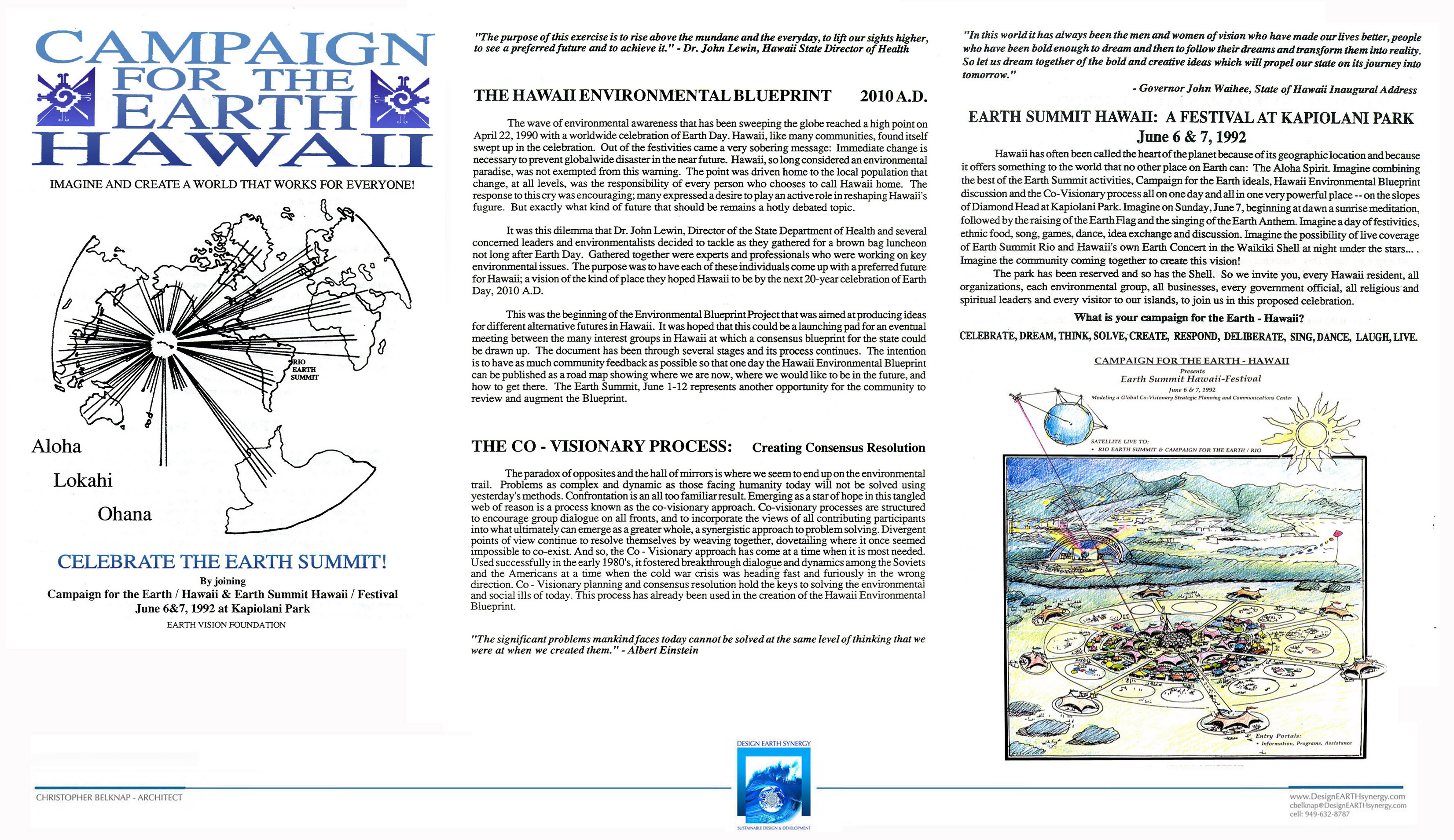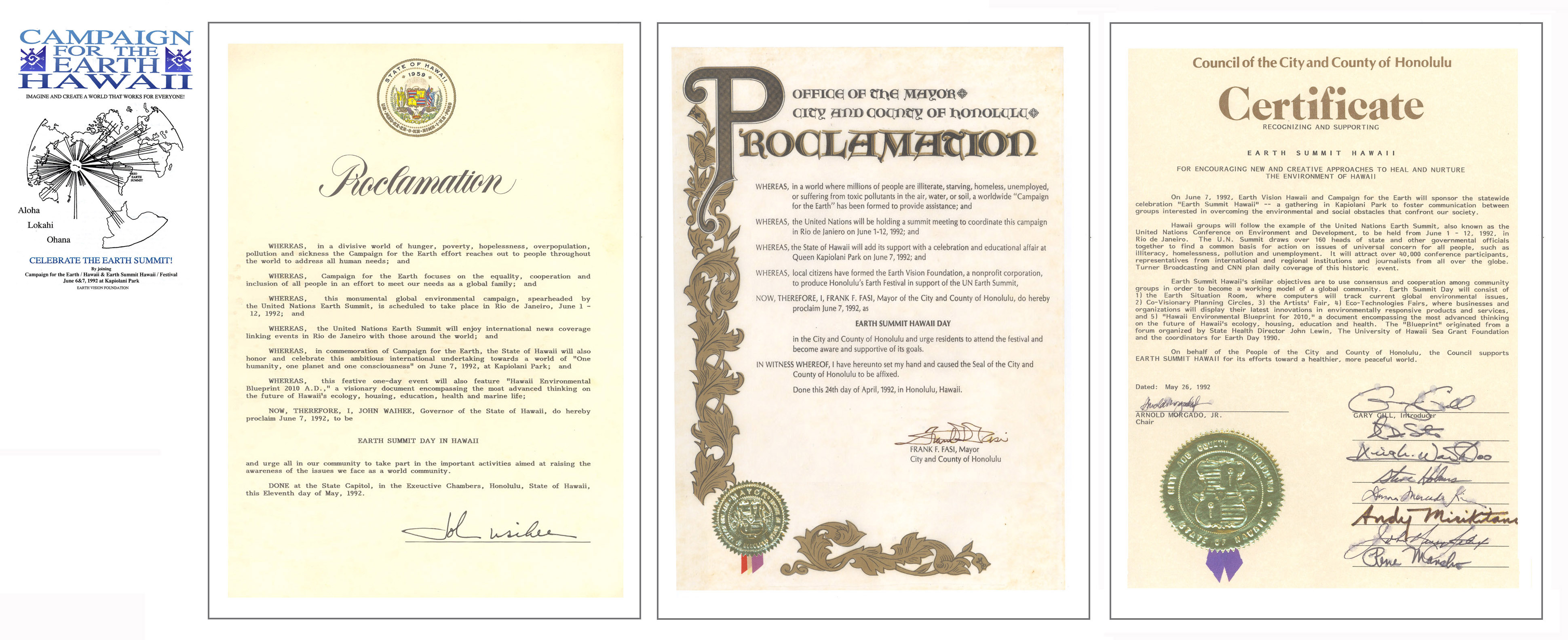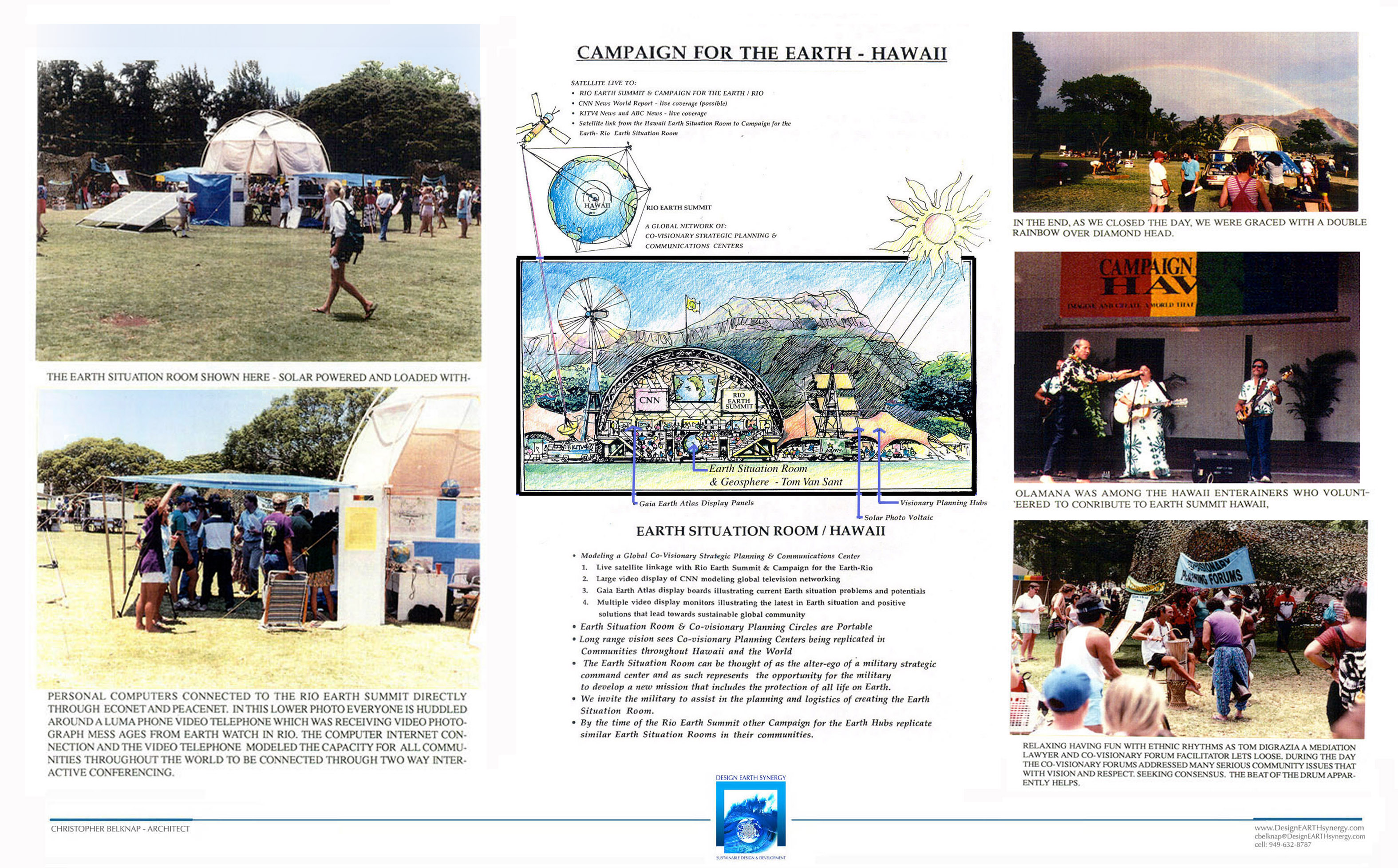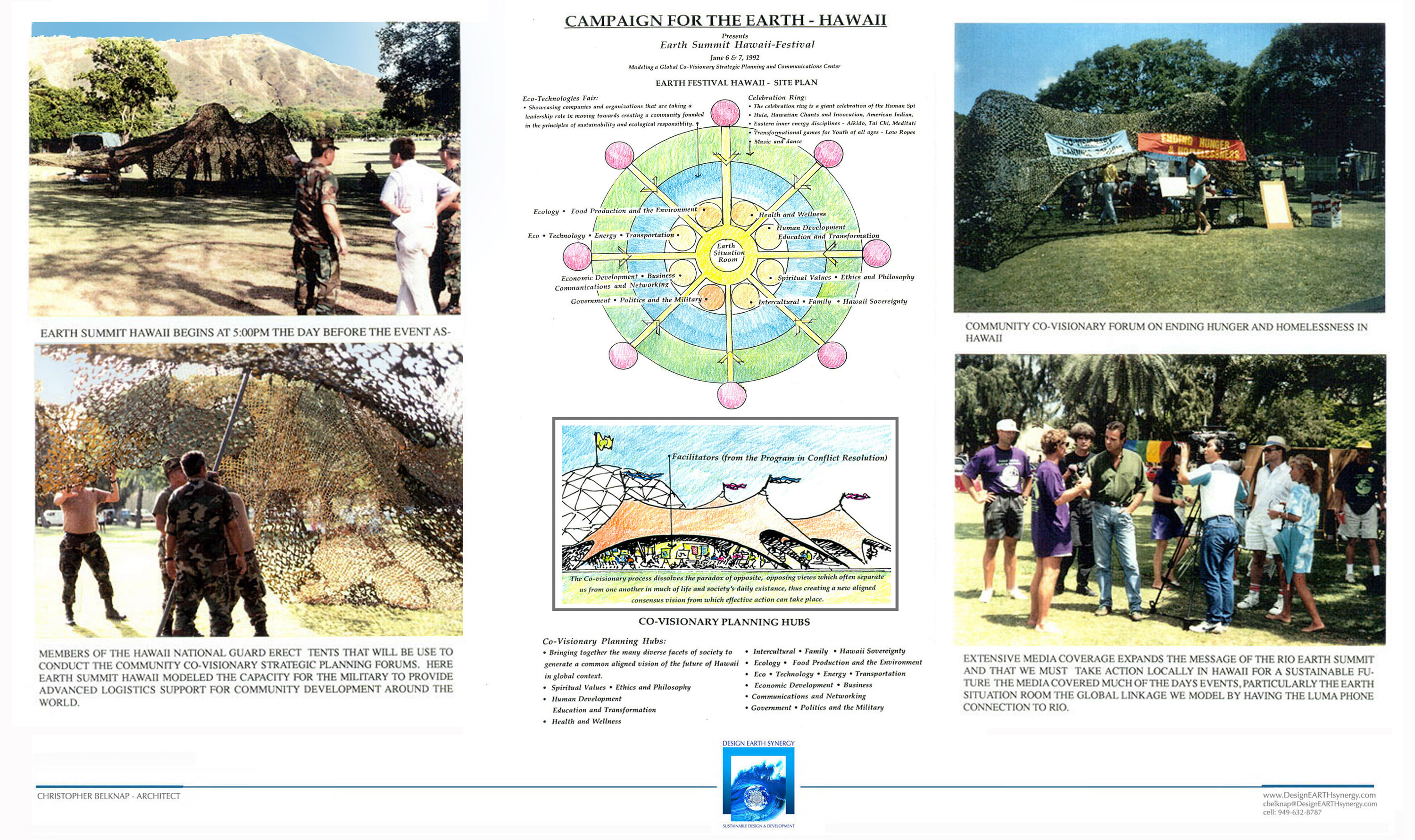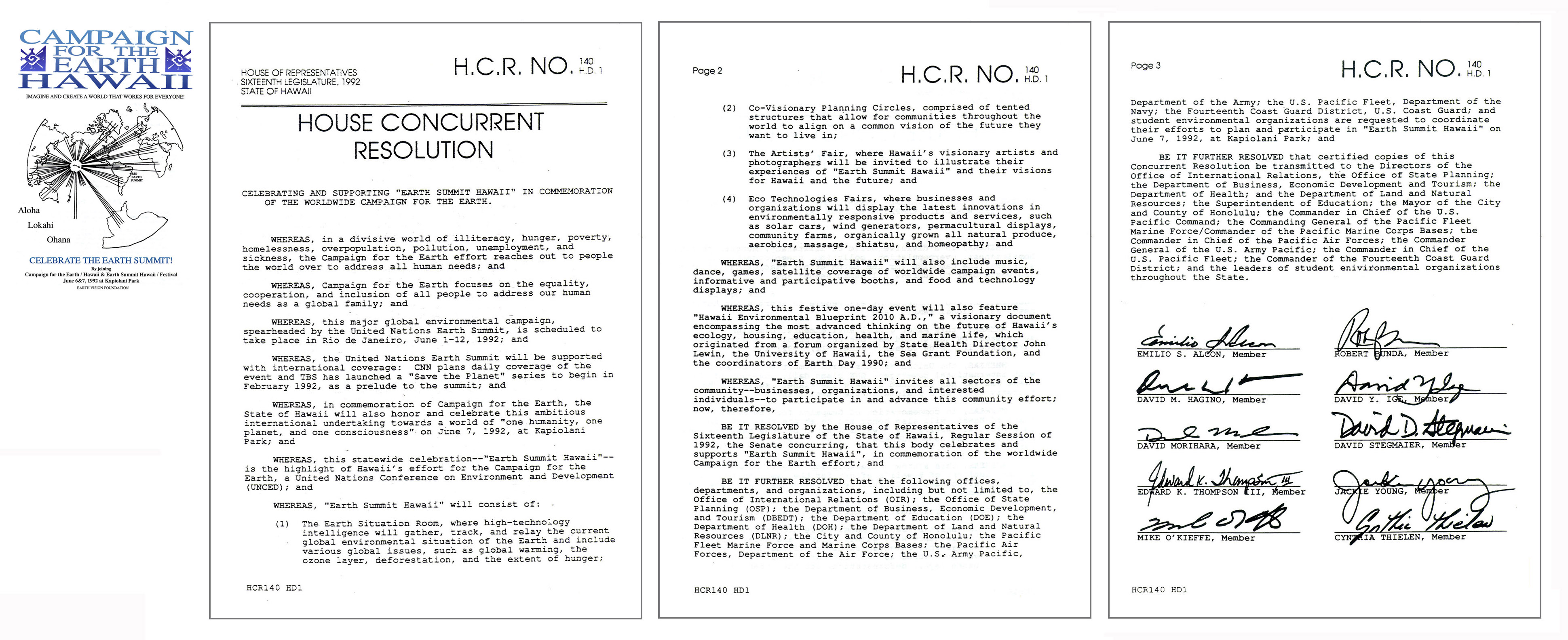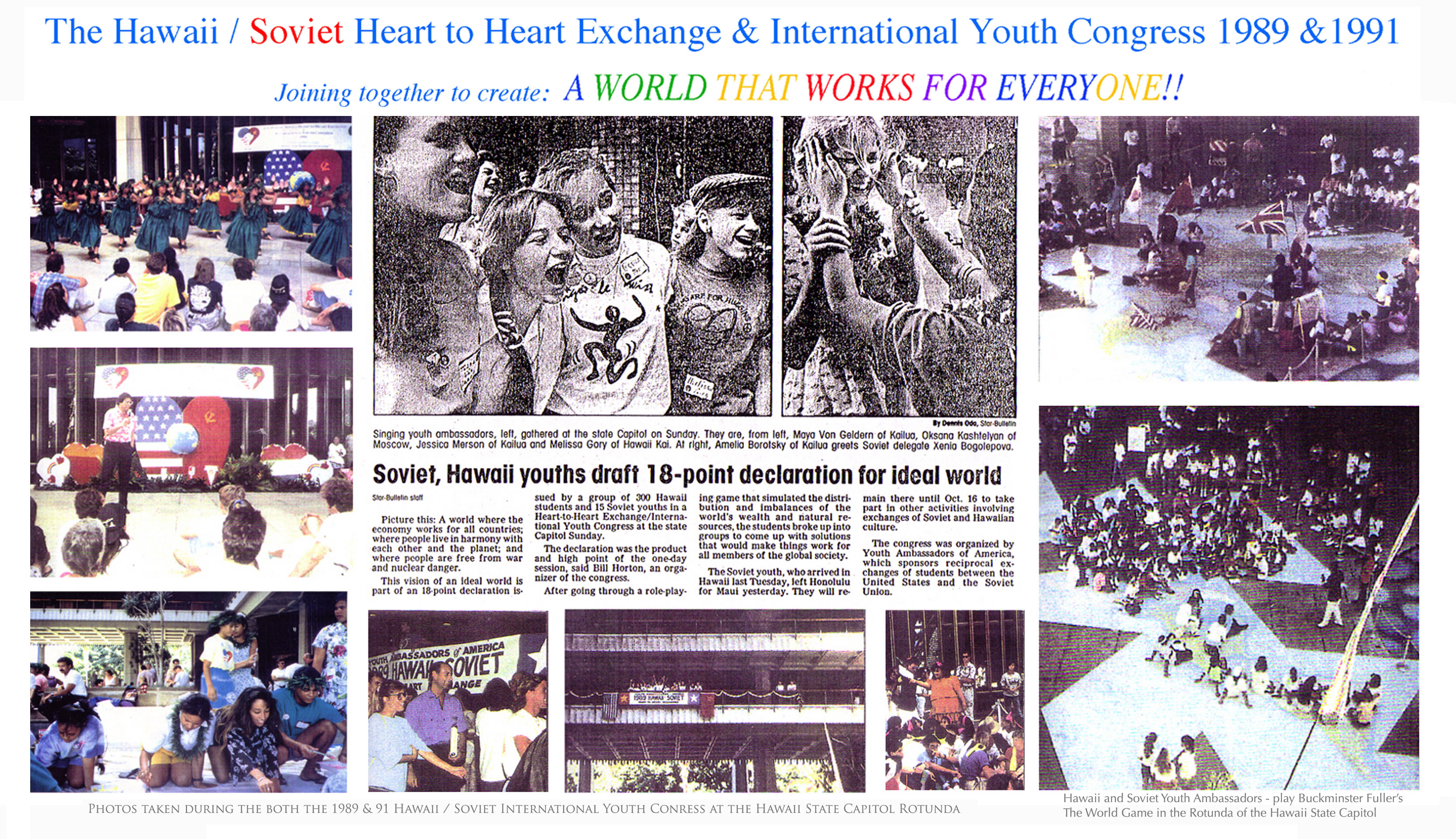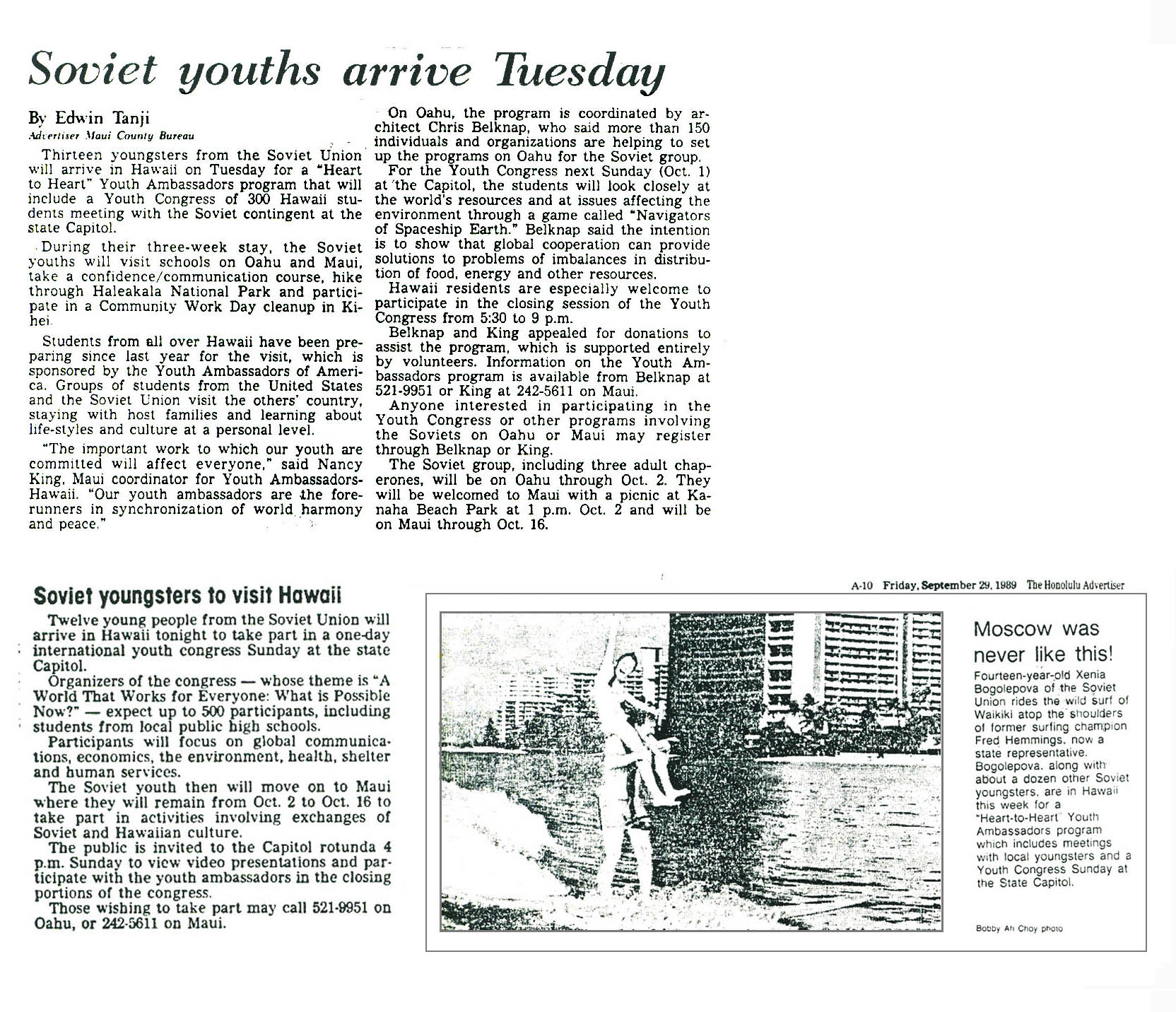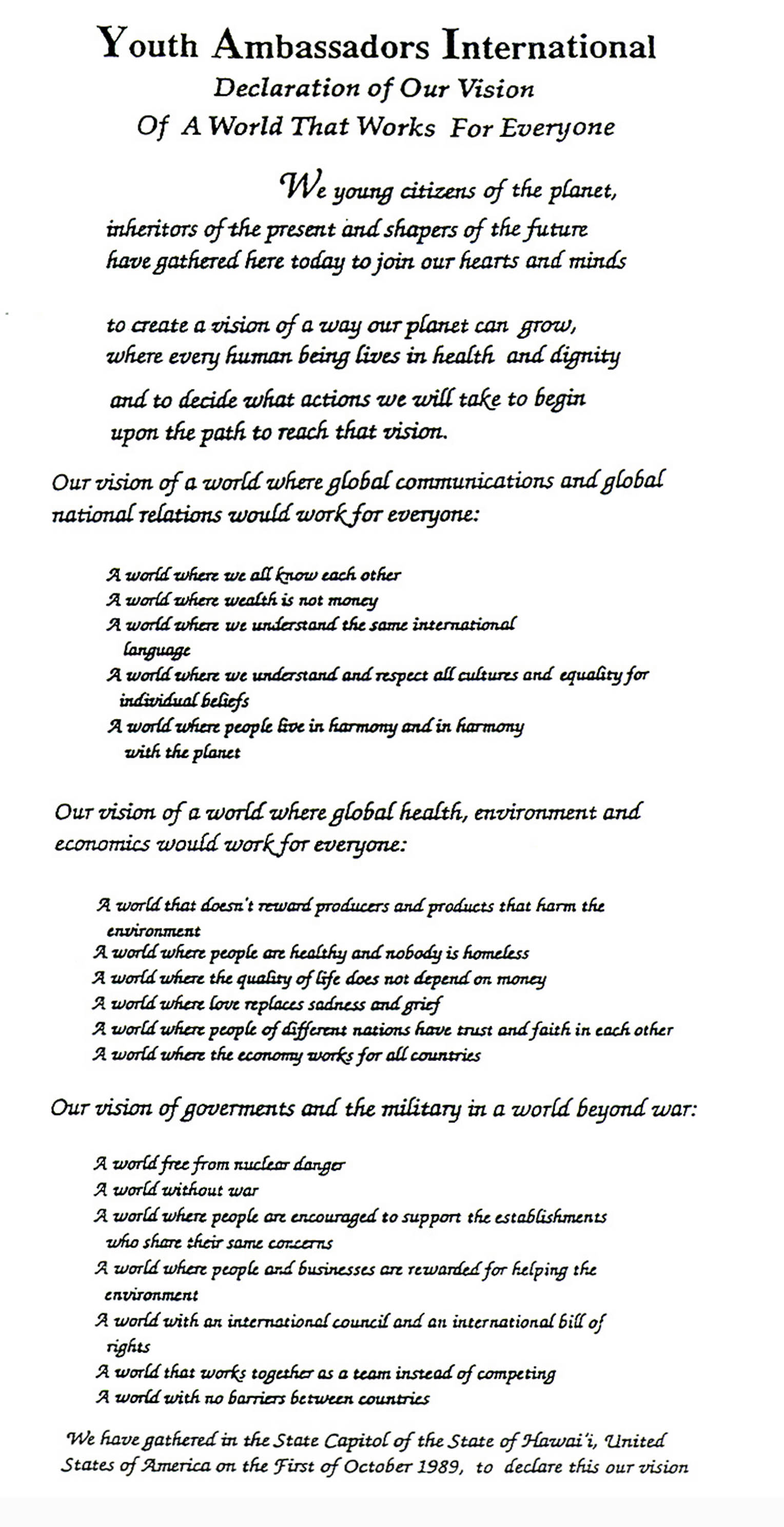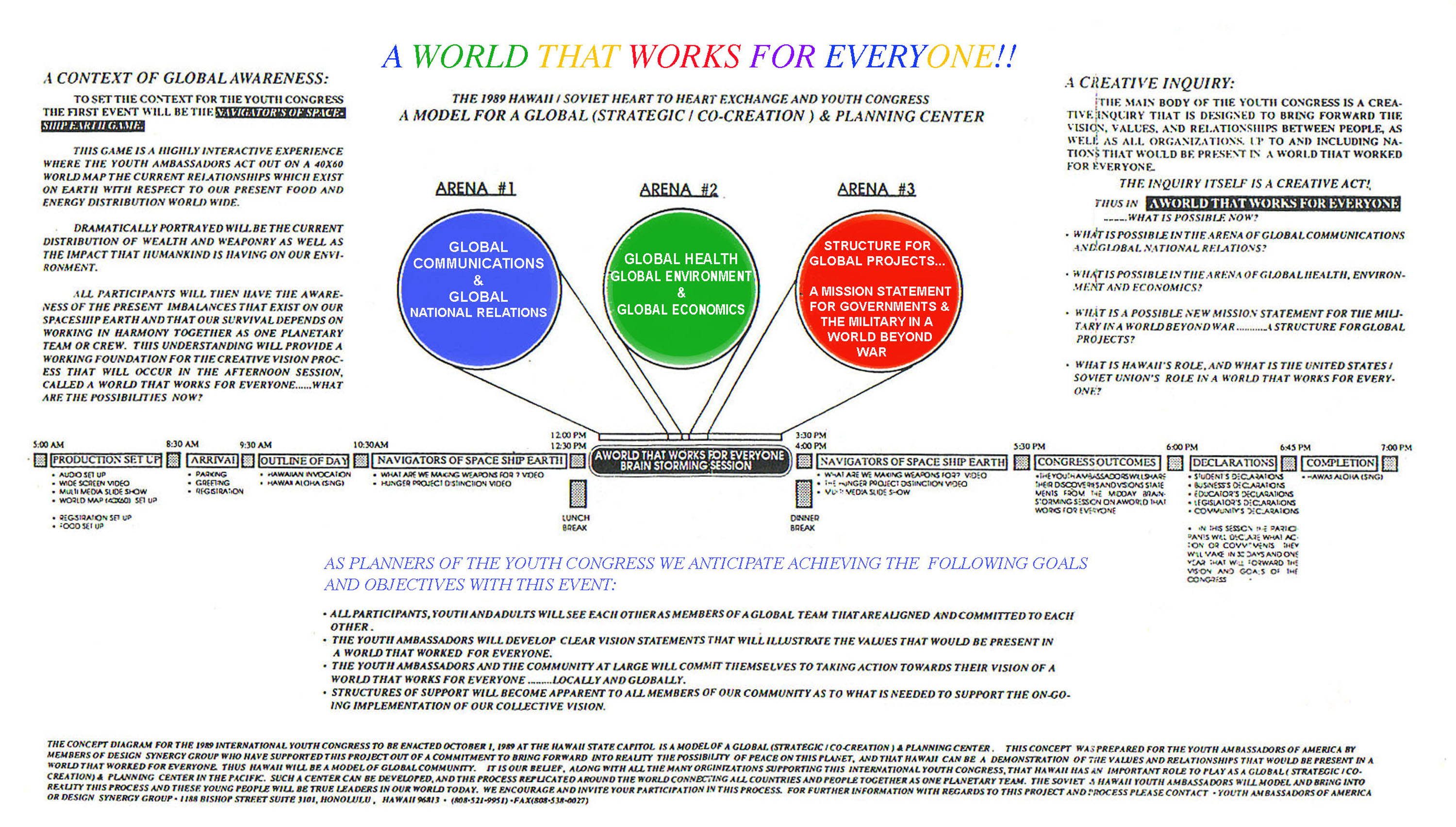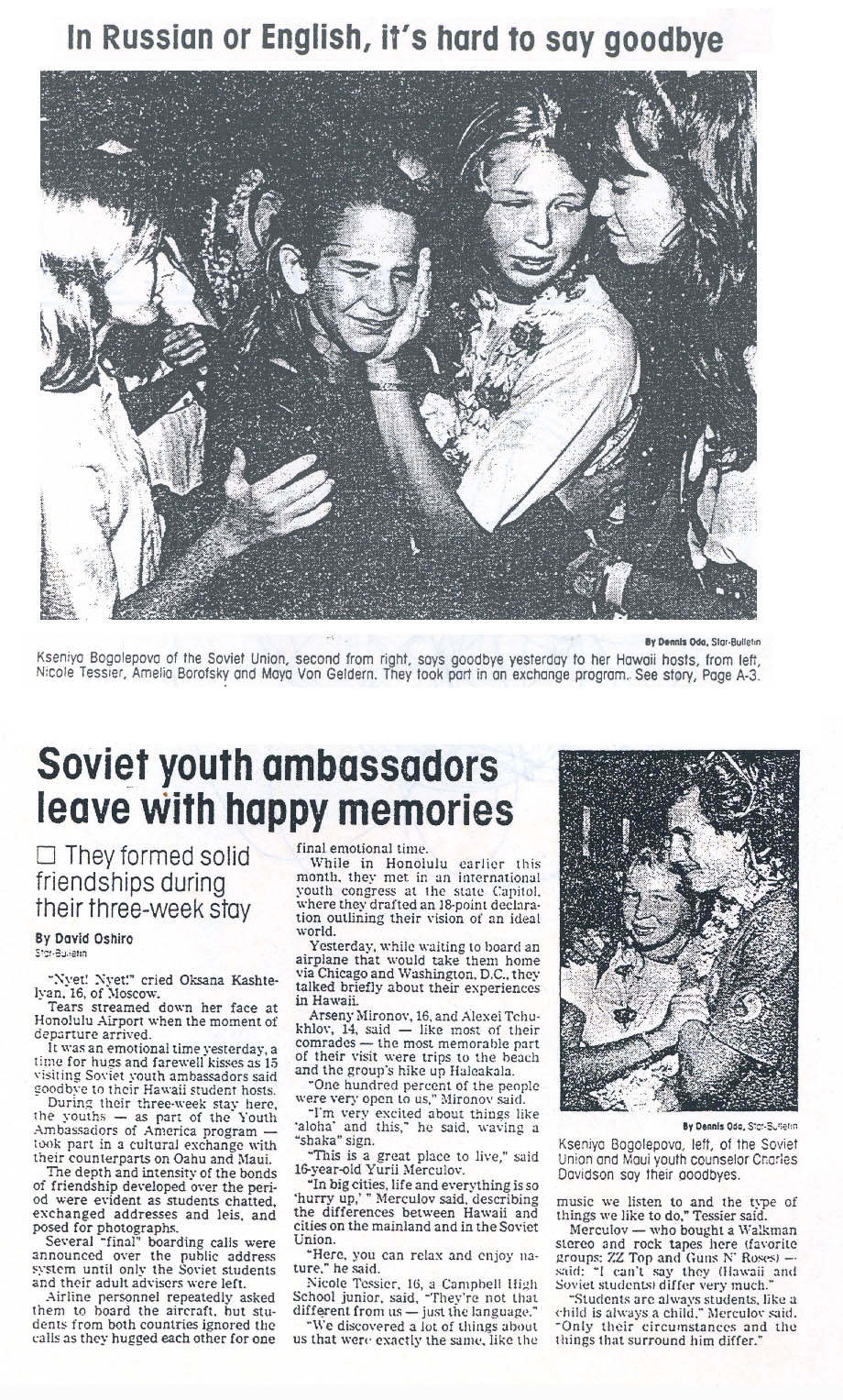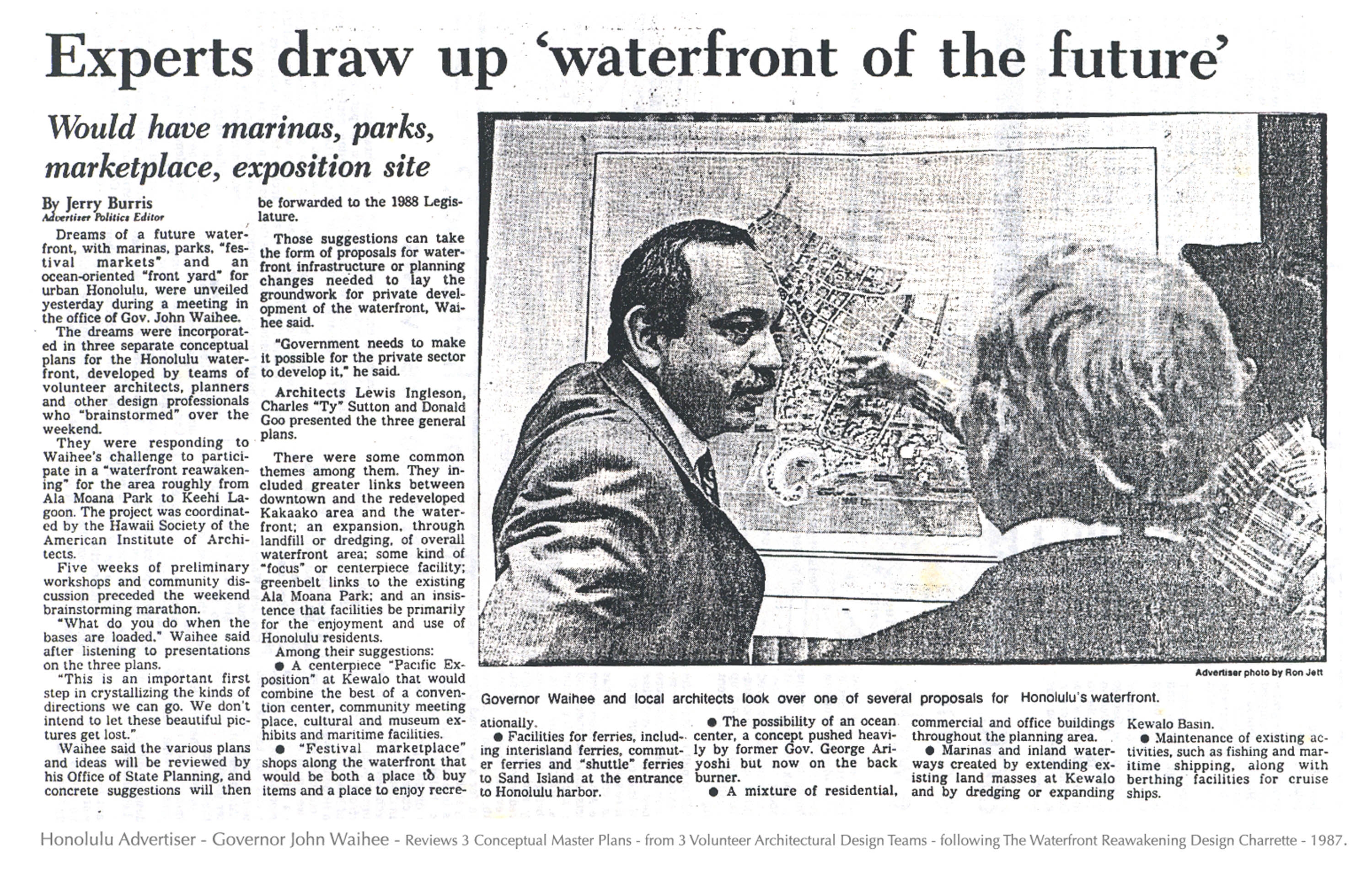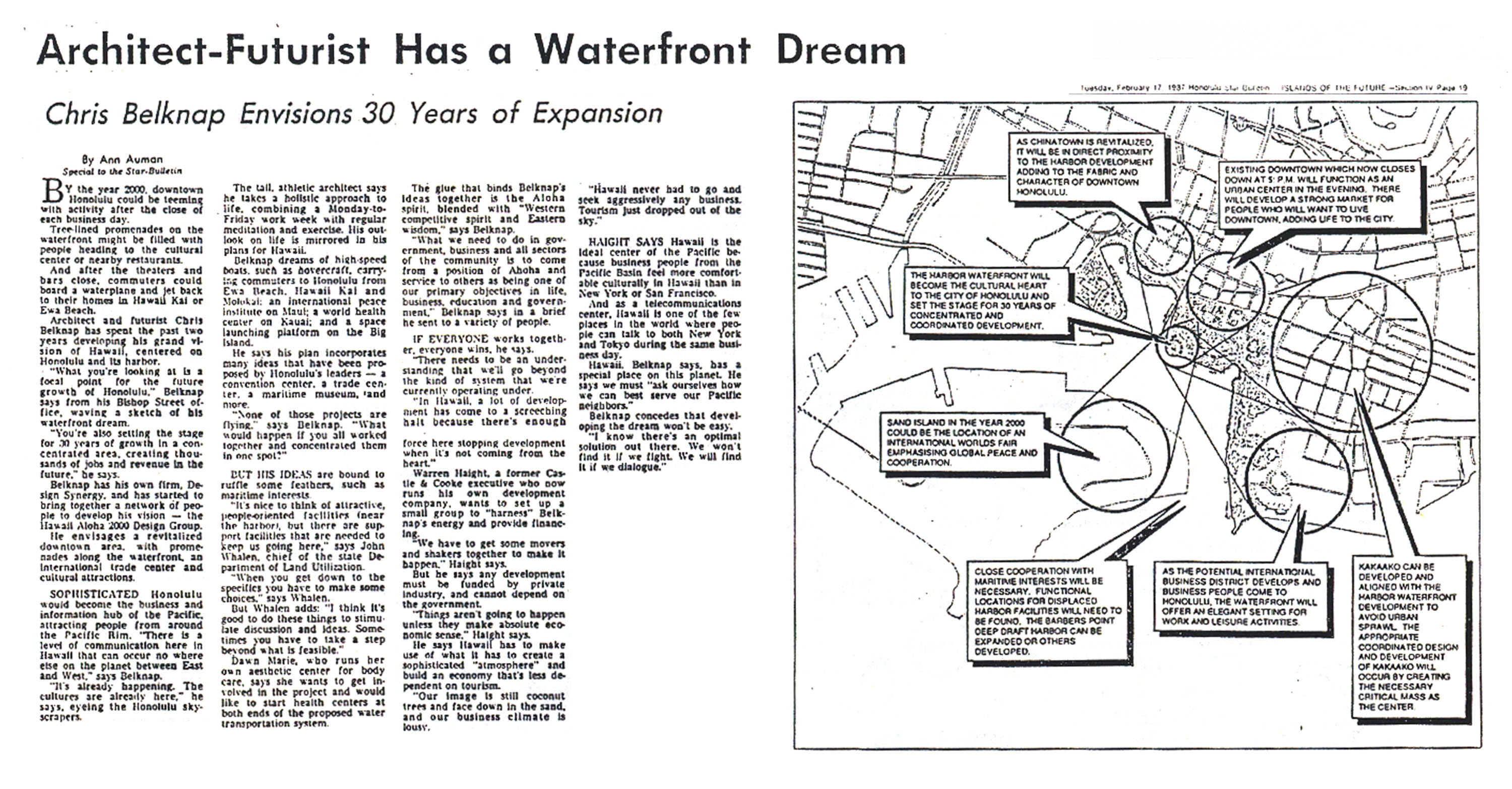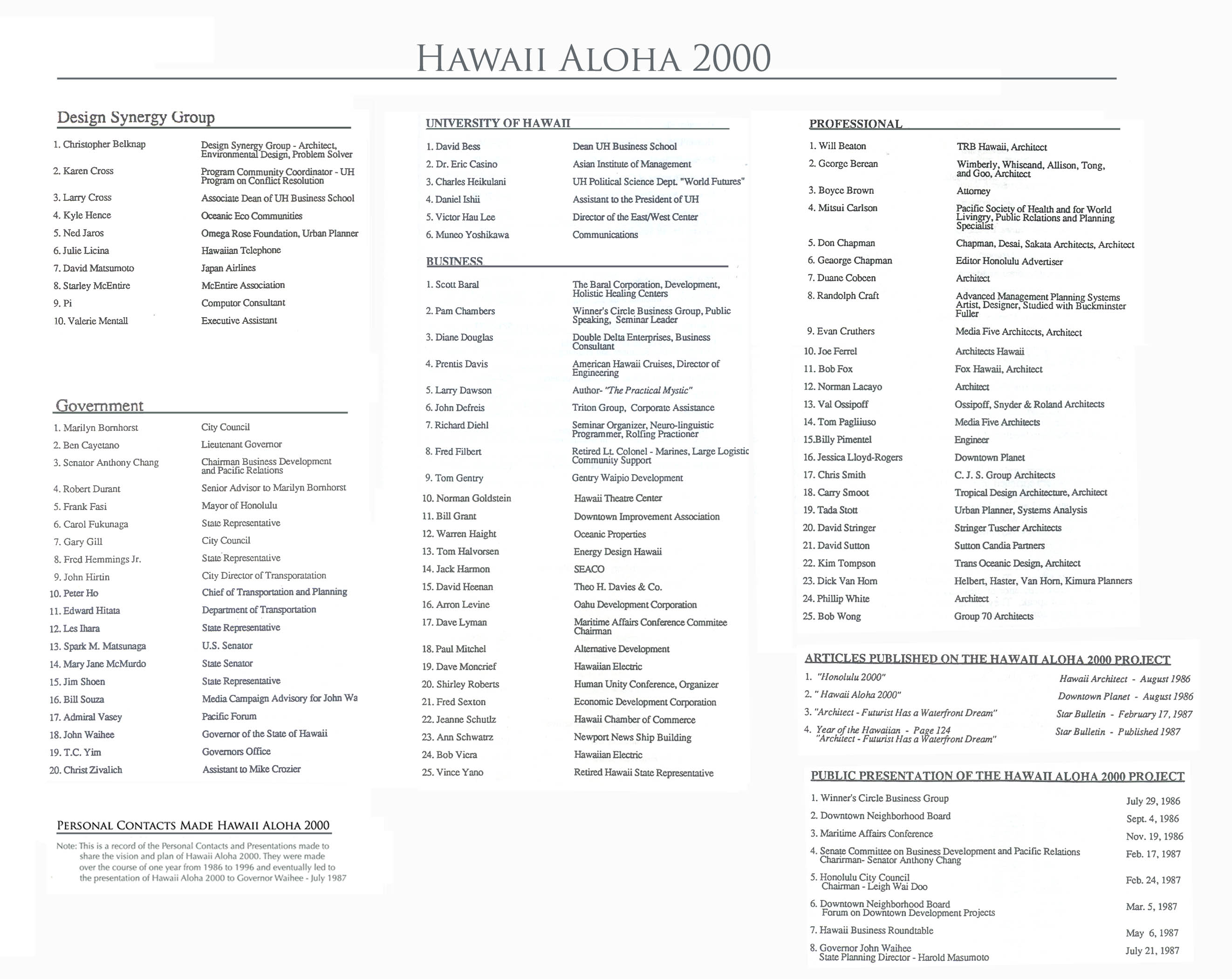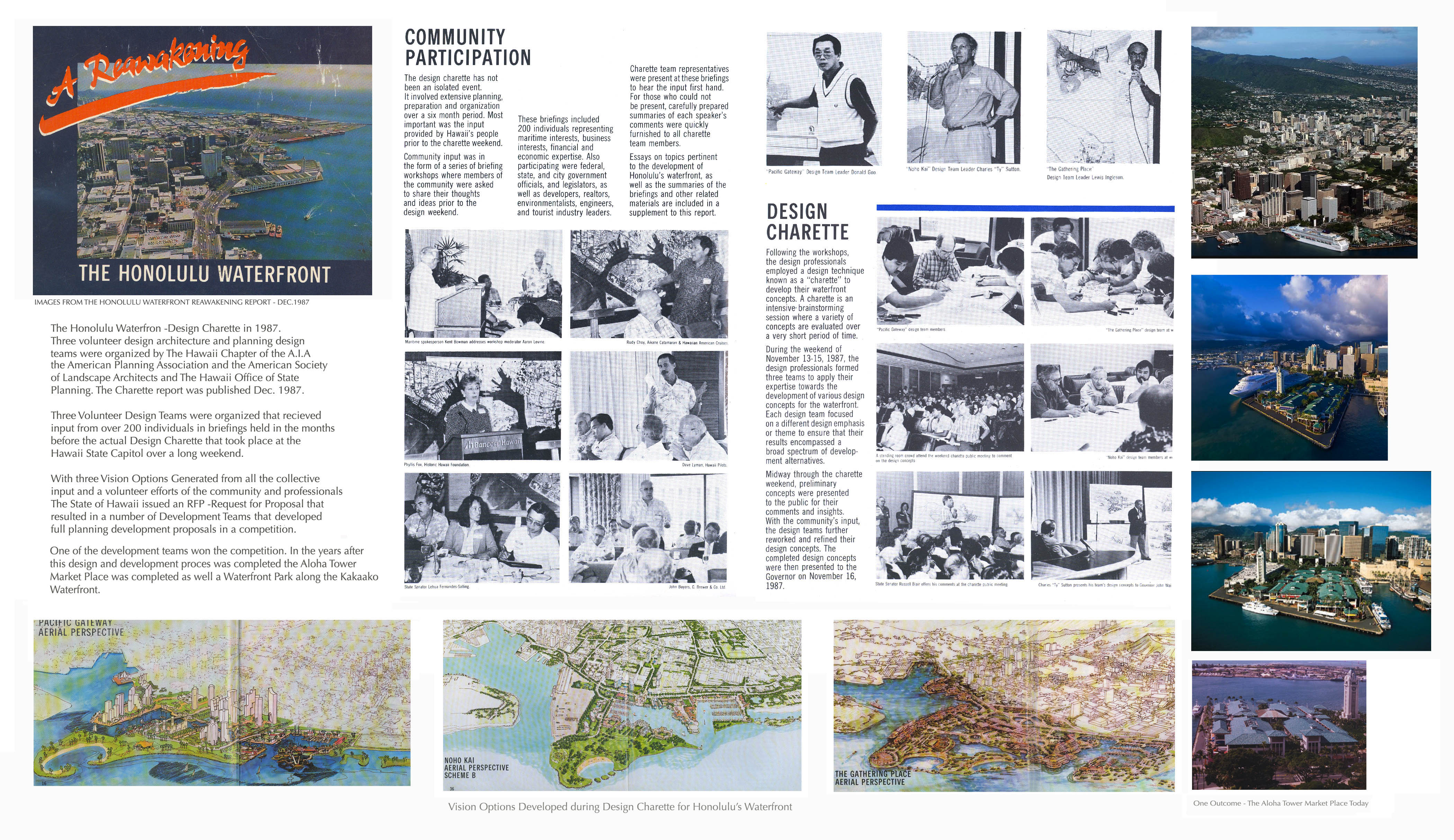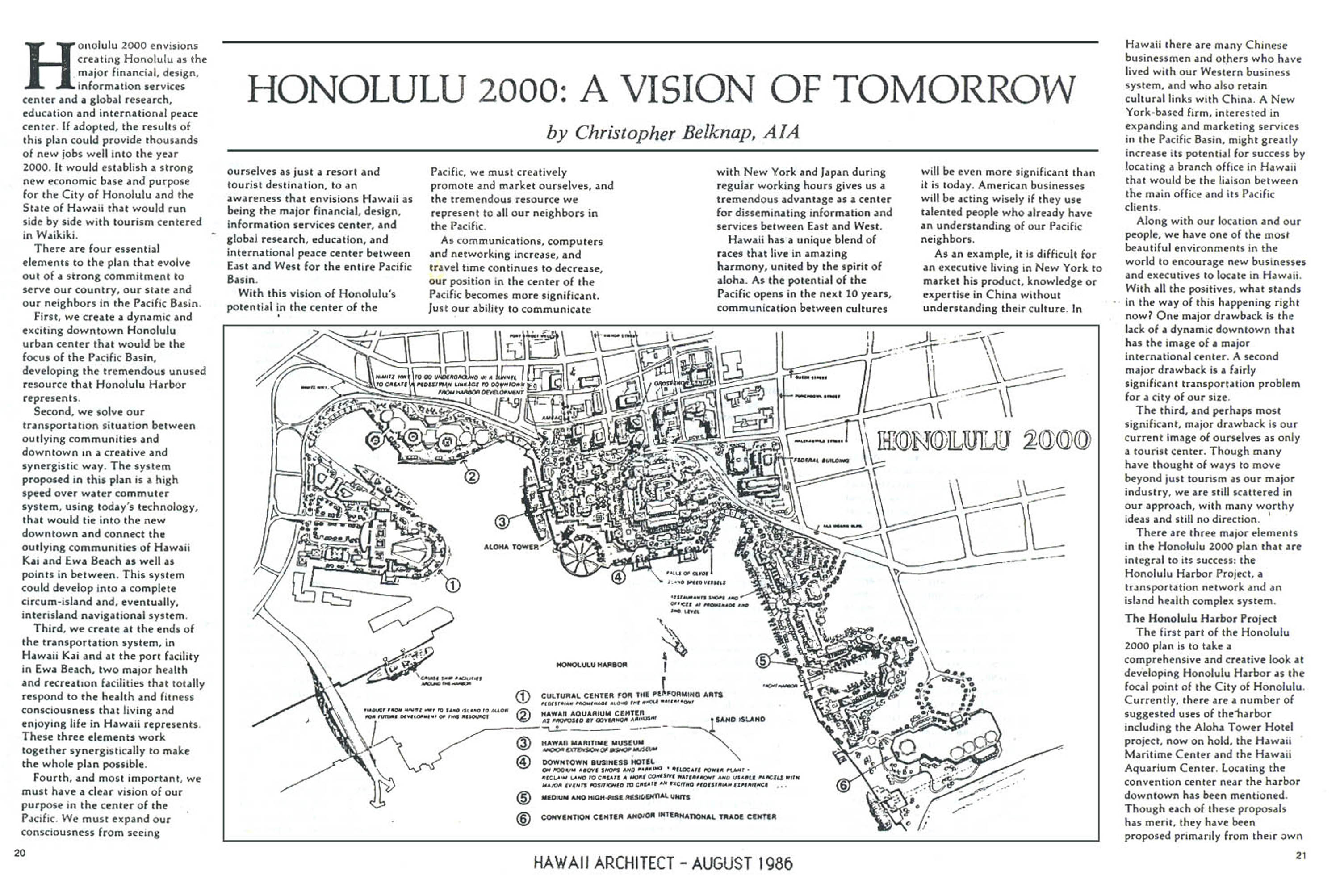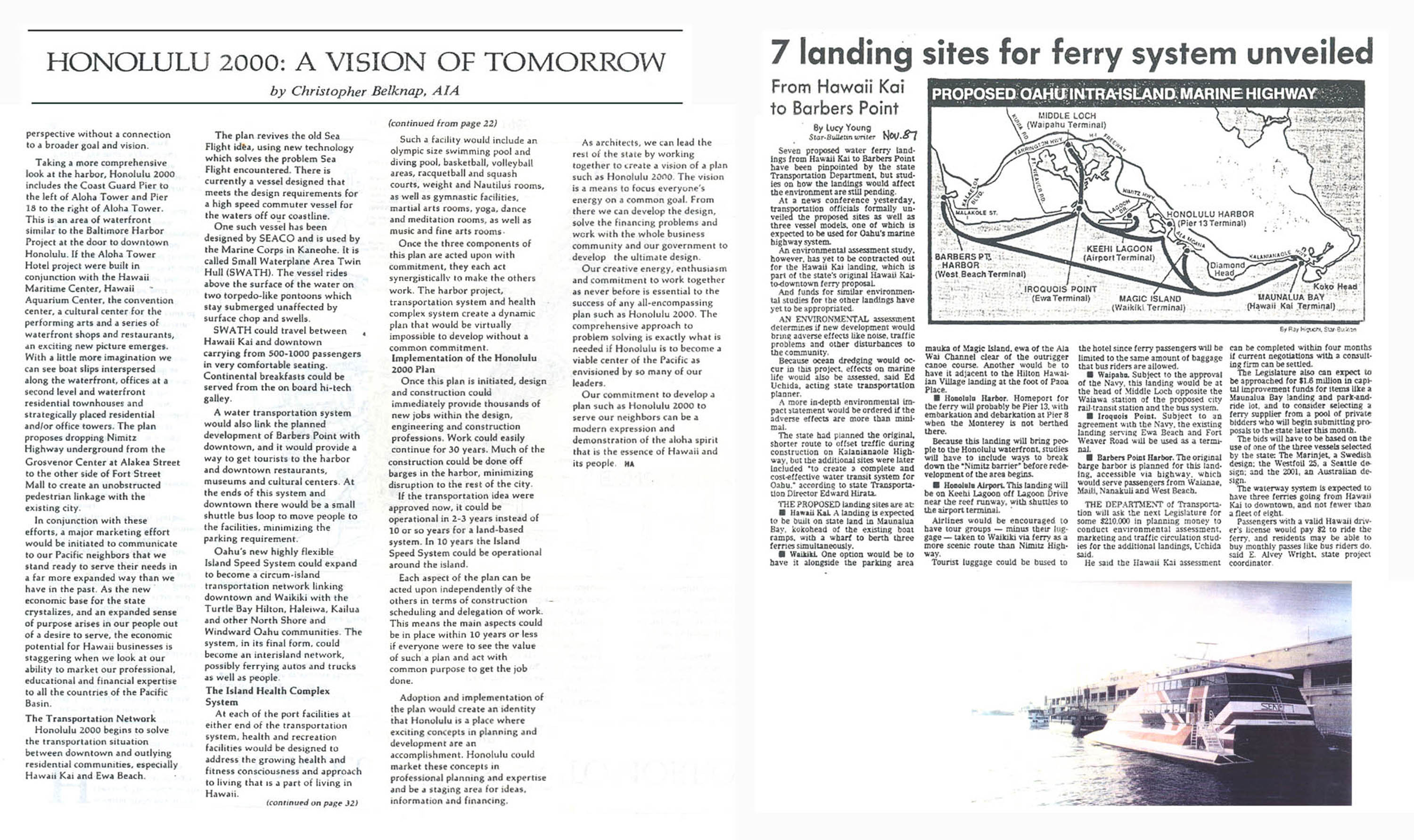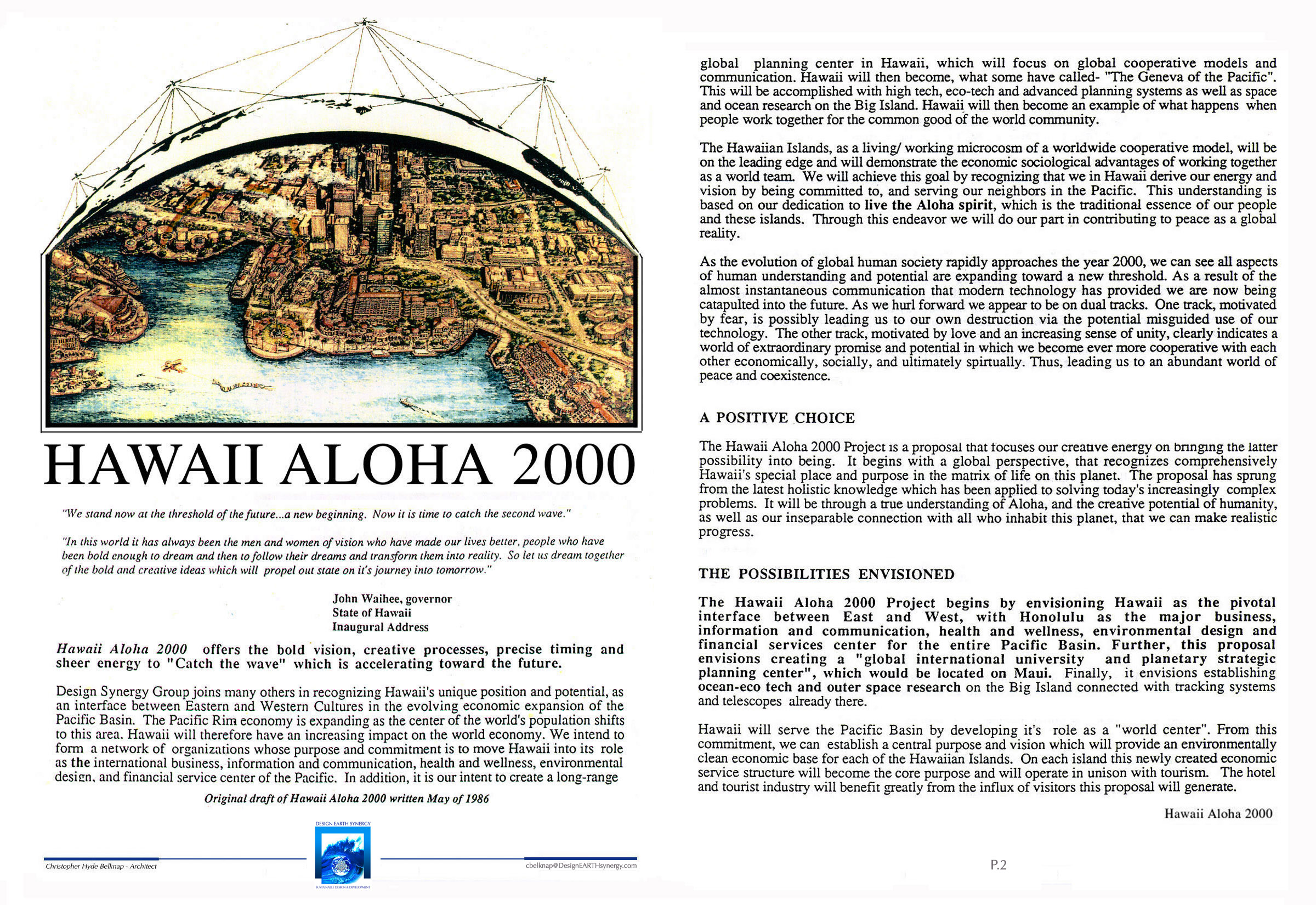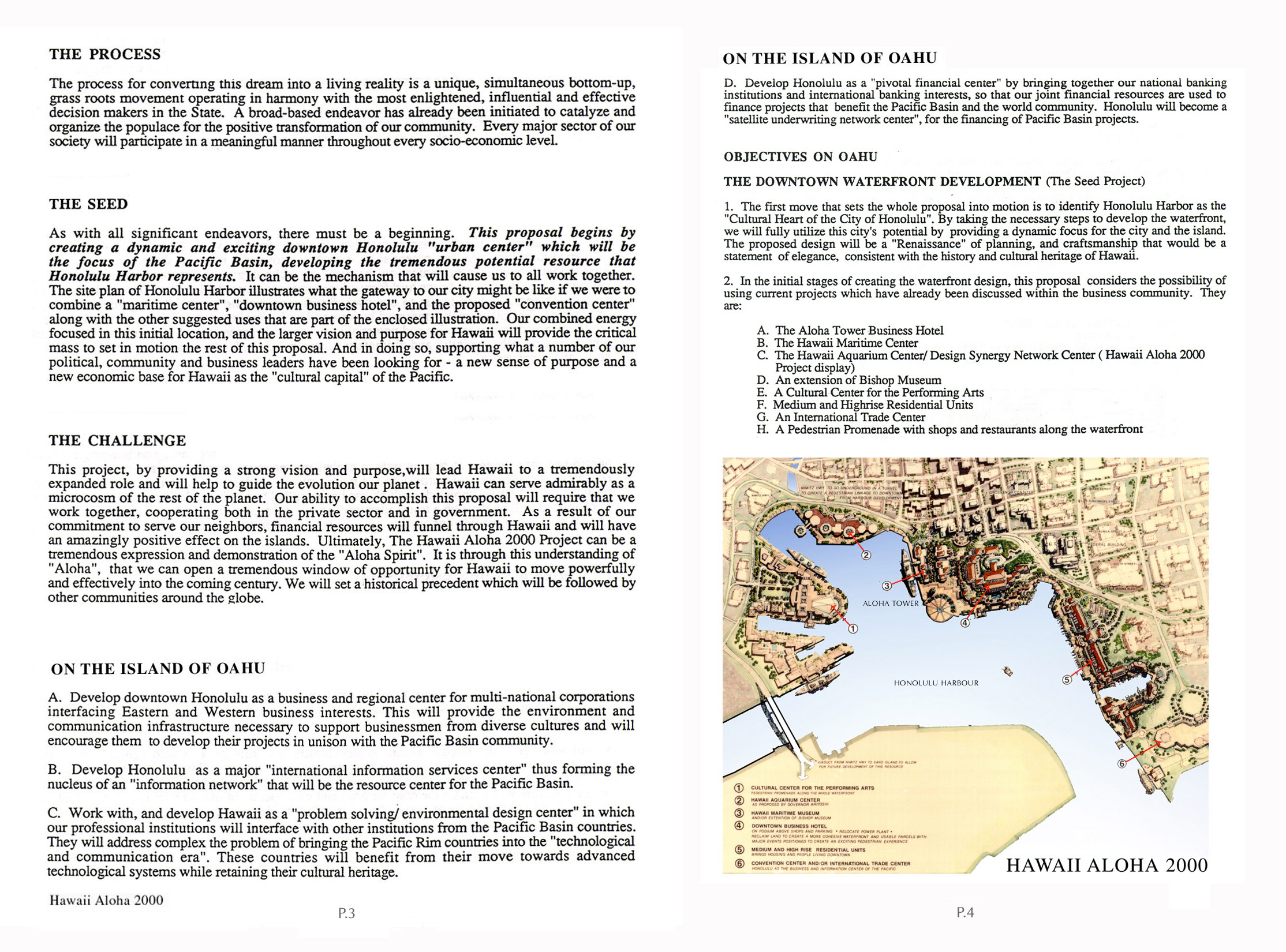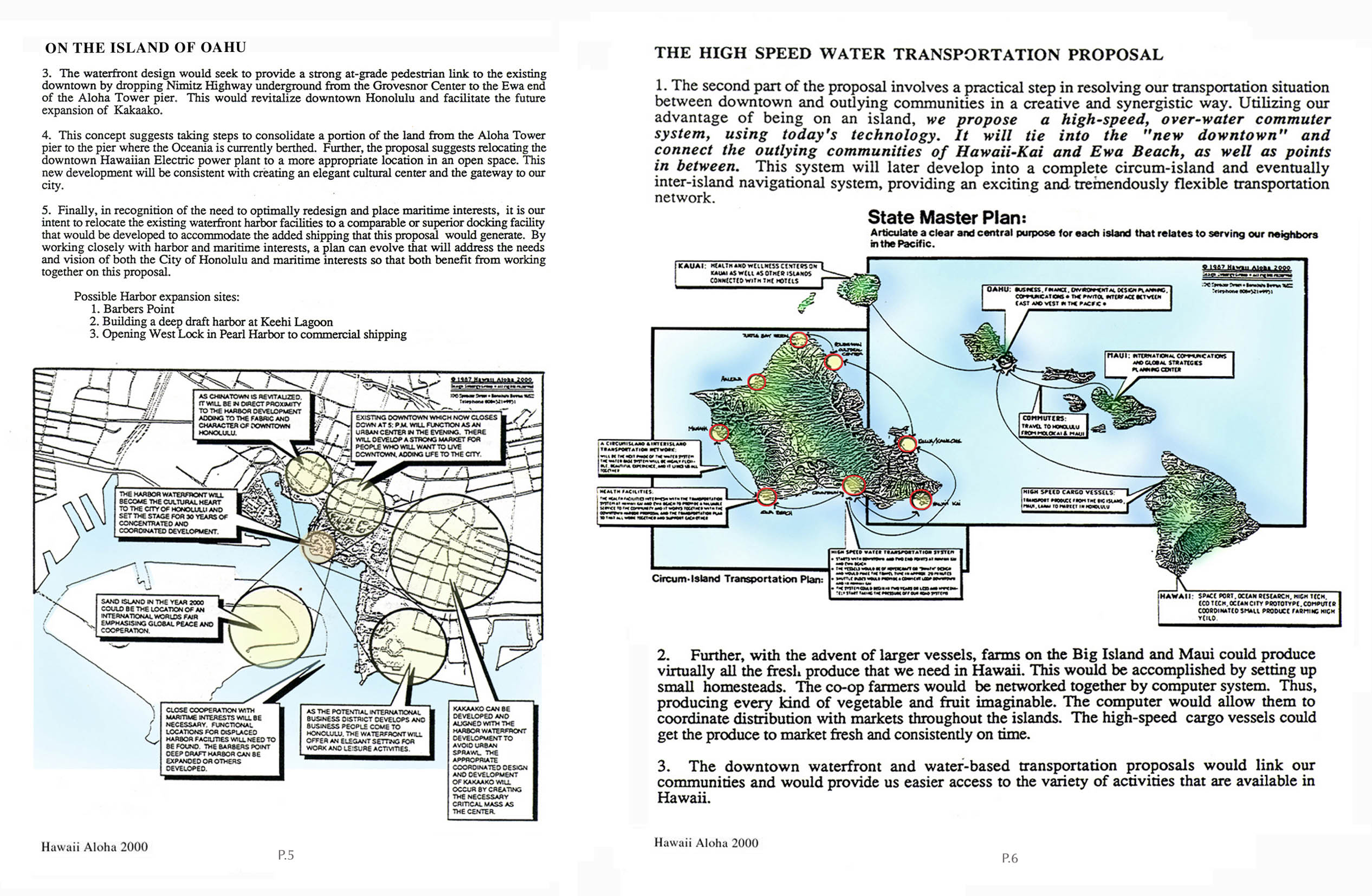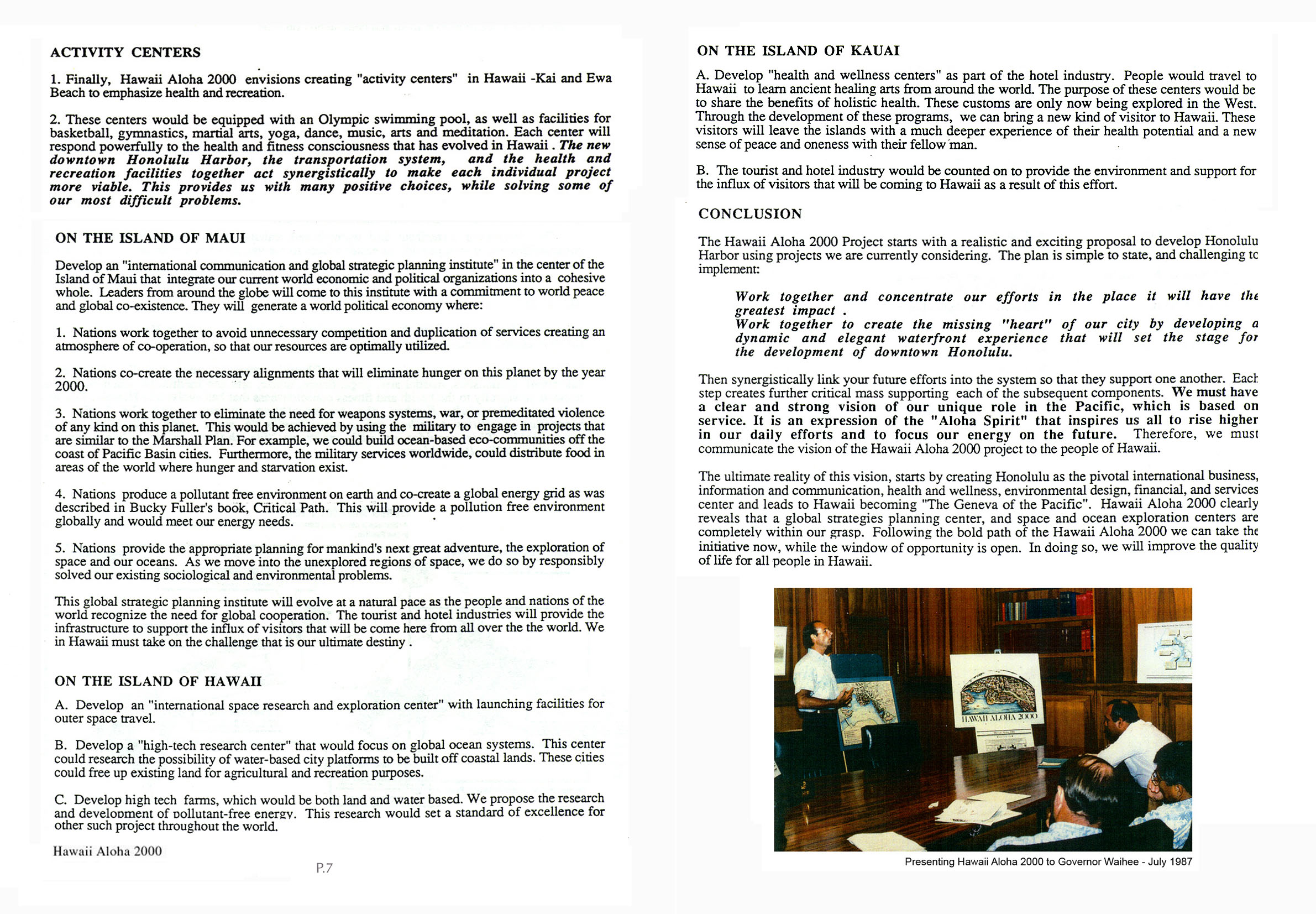Christopher Belknap – Design Earth Synergy
Sustainable Communities – Community Vision Center Planning Initiatives – Hawaii 1986 to 1996
Global Community Vision Center Initiatives
Eco Village – Prototype Sustainable Communities
Pacific Polis – Prototype Sustainable Cities
1986-1996 The State National & Global Community Vision Center Planning Initiative
This document presents an expansive strategy for creating a Global Network of Community Vision Planning Centers throughout the Nation and the World Community. The various Initiatives and illustrations describe the principles behind community vision planning, and the broad strategy for implementation. Along with Sustainable City and Eco Village initial Conceptual Plans and Initiatives this document outlines a strategy that can self organize communities at every scale to envision for their community a Vision and Action Plan and pathway to a Sustainable 21st Century Future by 2050 – Worldwide.
This is also a record of 10 years of very active Grassroots Local Community Vision Planning in Honolulu Hawaii, where hundreds of volunteers envisioned and organized these events, along with thousands of people who participated in them. We were seeking at the local community level, a better path of self empowerment and community collaboration to take action towards a Sustainable way of Living than was present at that time. In our hearts we knew that this was possible if we could find a way to cooperate and collaborate from a win / win perspective. In many respects during this time period these participants in Hawaii were, at least one point of many points of light that were emerging around the World, that were on the cutting edge of positive Global Change pioneering the creative and collaborative planning process to reach a more positive Sustainable Future.
Expand the first image below – this is a summary Illustration of the Design Earth Synergy Mission and Goals – Sustainable 21st Century Cities and Eco Villages as well as the Community Vision Center Process and Designs that is a central component of the approach to achieve a Sustainable 21st Century by the Year 2050.
Note: Click on all images or illustrations to expand – best on a wide screen.
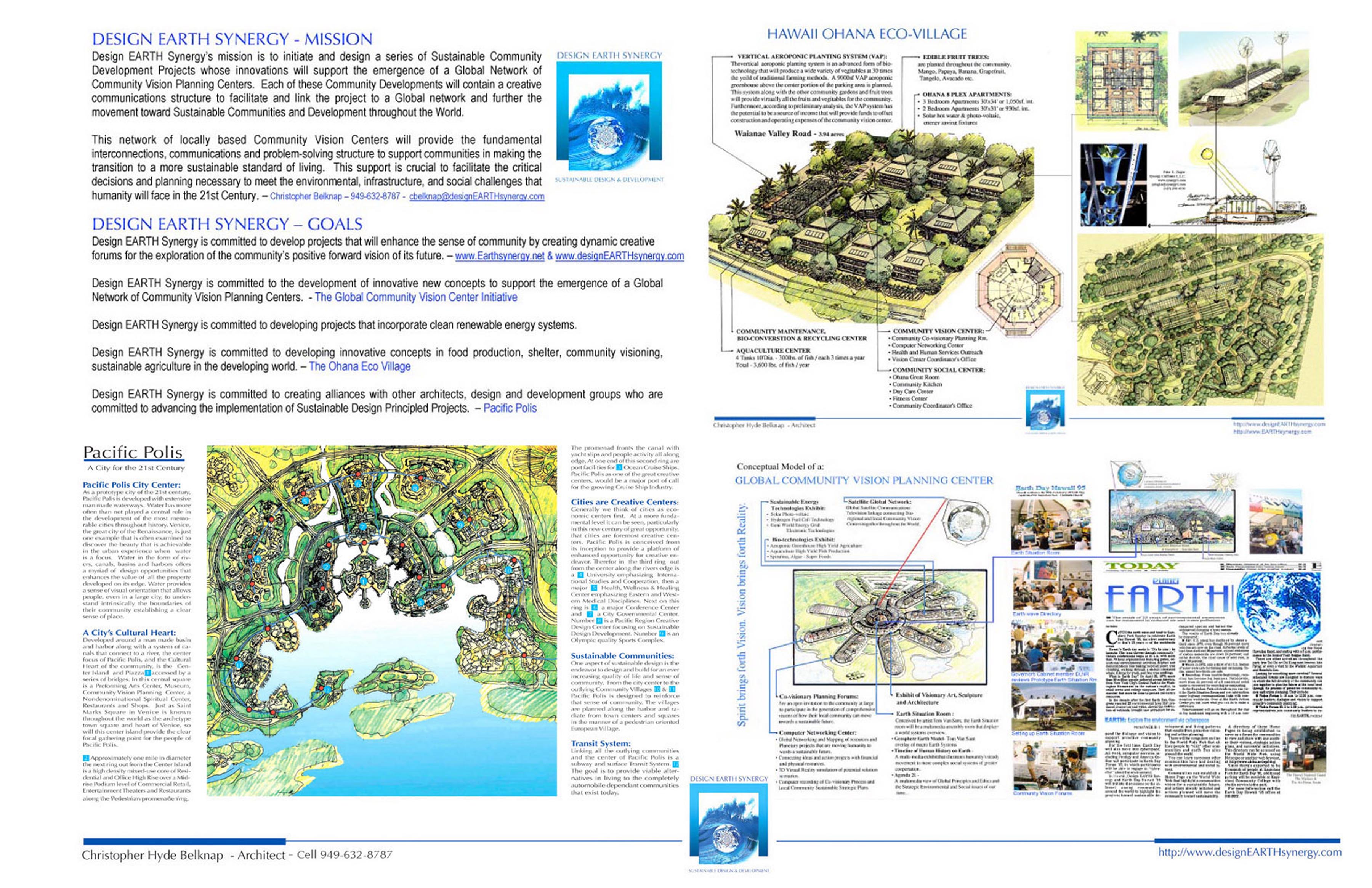
1995 Earth Day Hawaii & Design Earth Synergy – Community Vision Center / Earth Situation Room -Celebrating the 25th Year Anniversary of Earth Day:
Design Synergy coordinated a major portion of “The1995 Earth Day Celebration” in Honolulu focusing on the design and display of a prototype “Community Vision Center / Earth Situation Room.” With over 15,000 people in attendance that day, an Earth Situation Room was erected under a “Sprung Instant Structure” with 20 computers connected to the Internet.
Click on Images and Illustrations to Expand:

The Community Vision Center:
The primary purpose of an individual Community Vision Center is to achieve a consensus built vision at the local community level. This vision emerges from a dialogue and process that aligns the diverse and often opposing interests of community members towards consensus built vision and goals. Today this process is commonly called ‘Community Based Planning” and it is a process that has been gaining momentum in communities throughout the country for a number of years now.
An Evolutionary Step in Democracy:
The process of community vision consensus building can be considered an evolutionary step in democracy that is much needed at this time, given the complexity of seemingly conflicting issues a typical community must resolve today. Consensus built vision and action plans enhance all our democratic institutions’ ability to function far smoothly.
Community Vision Center Connected to a National and Global Network via the Internet:
As each local Community Vision Center is established with a clear vision and action path it would be connected, via the Internet, to all other emerging Vision Centers throughout the State, the Nation and the World. The Community Vision Centers and this consensus built dialogue will create a communications structure of sufficient flexibility to facilitate positive creative thinking in communities throughout the Nation and the World Community. The interconnection of the local community visions via the Internet will greatly enhance our ability to navigate the difficult challenges ahead on the path to a sustainable way of living and it will create a very strong force for positive change.
1994 – Letters of Recommendation from Governor Waihee and Senator Inouye for Christopher Belknap to meet with President Clinton & Vice President Gore regarding Earth Summit Hawaii and The Global Community Vision Center Initiative:
Each of the events and initiatives described below were organized to illustrate the value and purpose of the collaborative and consensus building “Community Vision Planning” approach to solving complex and often competing priorities in City and Community Planning at the local level in Hawaii. Each event brought to the community clear examples of the possibility of such an approach.
In 1994 letters of recommendation were provide by Hawaii’s United States Senator Daniel Inouye and Hawaii’s Governor John Waihee. These recommendations were provided to request a meeting with both President Clinton and Vice President Al Gore.
The goal was to expand this initiative so that many more communities would participate in this process during the 30th Year Earth Day Celebrations in 1995. The highest level meeting that resulted was with Katie McGinty who was an adviser on the environment to Vice President Gore and President Clinton.
The events were produced in Hawaii with the Prototype Earth Situation Room during The 30th Earth Day Celebration modeled how Communities all over the Nation and World Community could use the Collaborative Visioning Process and connect via then early Internet to Collaboratively Envision and Plan for their own sustainable future -and seeds were planted for the future, which is now upon us.
Click on Images and Illustrations to Expand Letters of Recommendation:
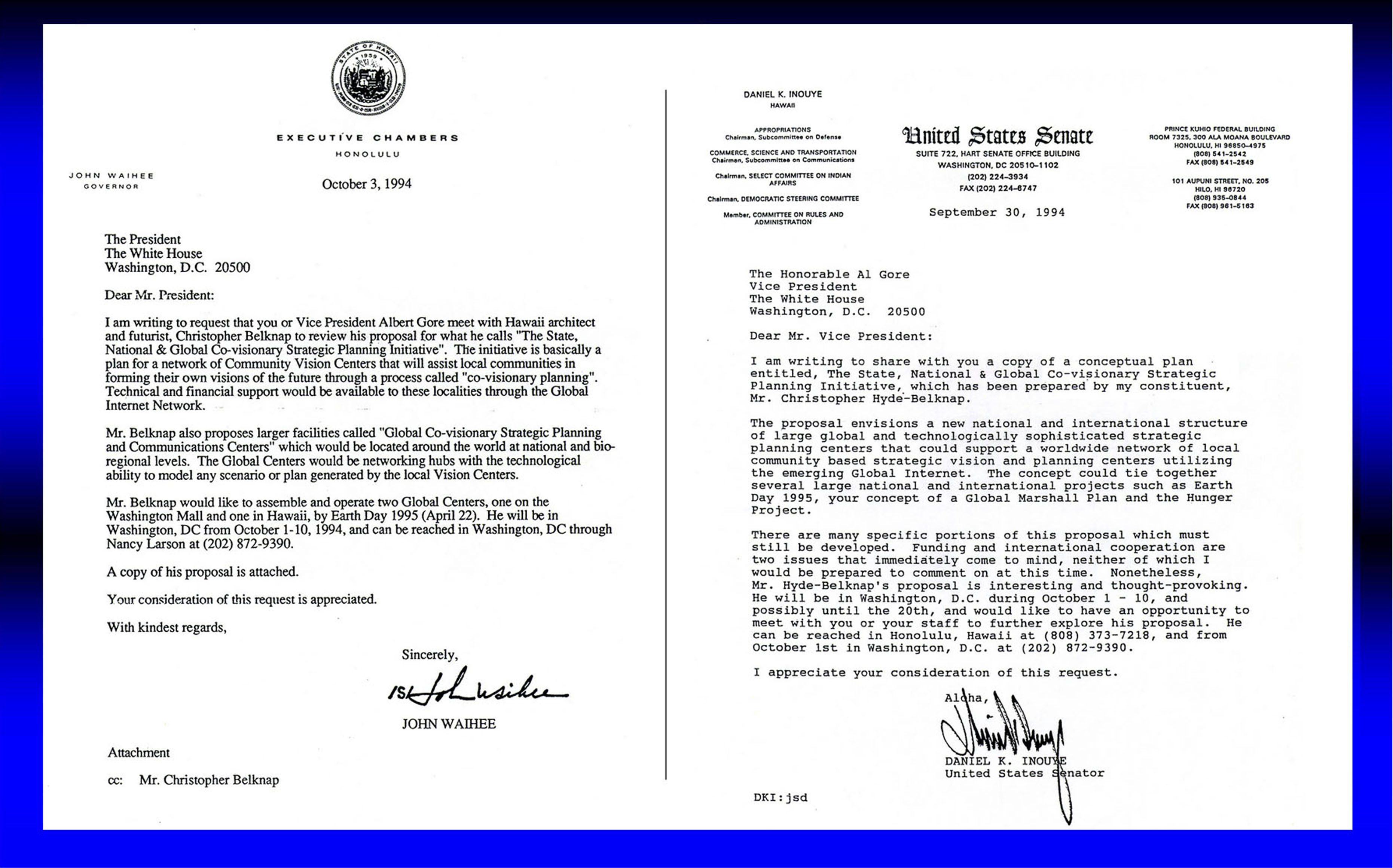
1995 – Earth Day Hawaii & Design Earth Synergy – Community Vision Center / Earth Situation Room:
Design Synergy coordinated a major portion of “The1995 Earth Day Celebration” in Honolulu focusing on the design and display of a prototype “Community Vision Center / Earth Situation Room.” With over 15,000 people in attendance that day, an Earth Situation Room was erected under a “Sprung Instant Structure” with 20 computers connected to the Internet.
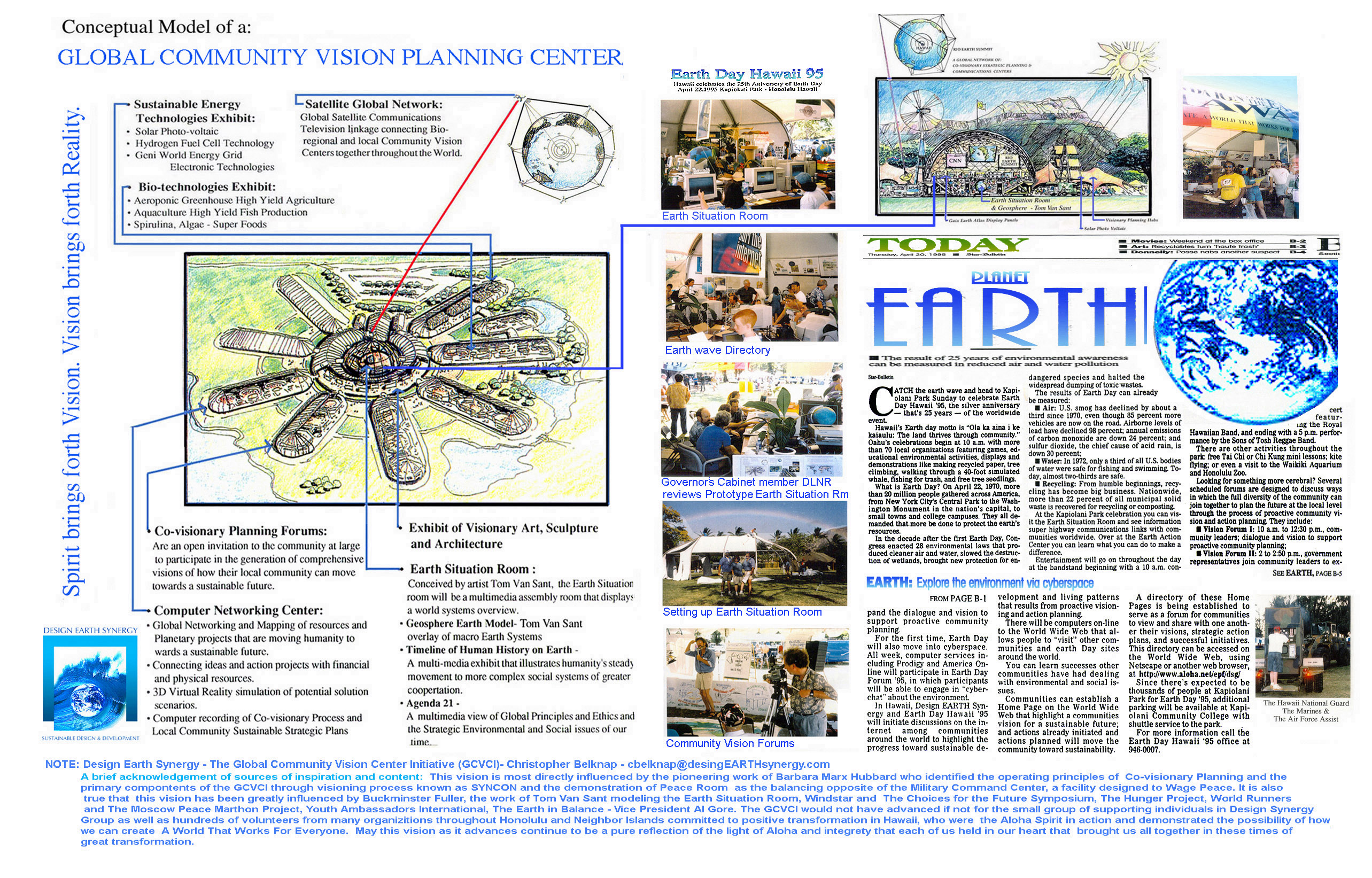
Community Visions Posted on the Internet:
The Design Earth Synergy Web Site was posted on the Internet showing the Global Community Vision Center concept. On the Earth Wave Directory, community members were actively collecting the vision statements from those communities that already posted their vision for a sustainable way of living on the Web.
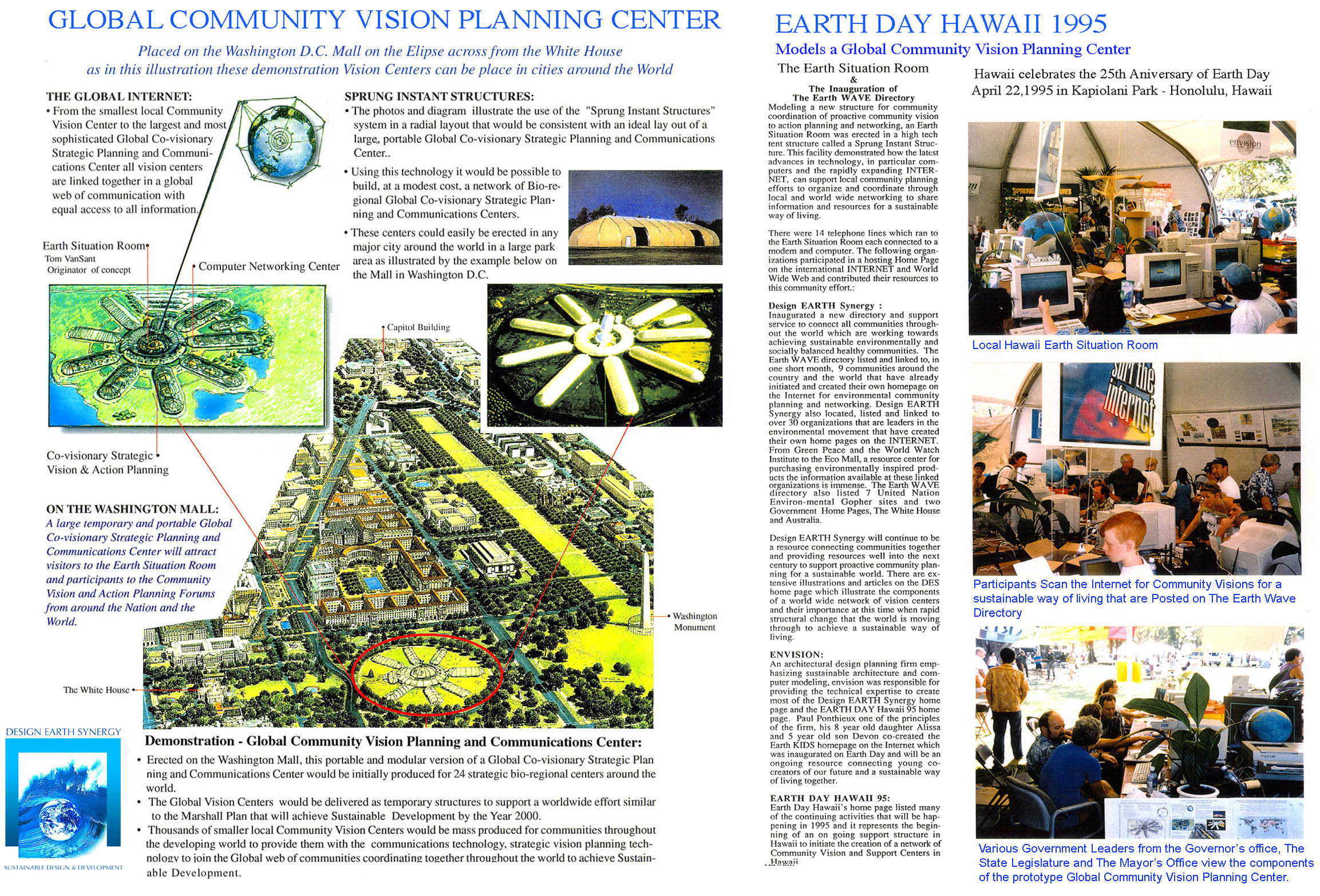
Global Vision Planning Centers – to be setup in 12 Major Cities around the World:
It is envisioned that large radial Global Community Vision could be setup in at least 12 Major Cities around the World.Within each Global Vision Planning Center would a Central Earth Situation Room – for major presentations of the current Global Earth Sustainable Living Situation.
A center circulation corridor has displays of Sustainable 21st Century Initiatives from around the World Community. Out on the radial spokes there would be a series of Community Vision Planning Rooms where people from around the Nation or Region would be guided through the process of Collaborative Vision Planning and express their ideas and vision for the betterment of their community.
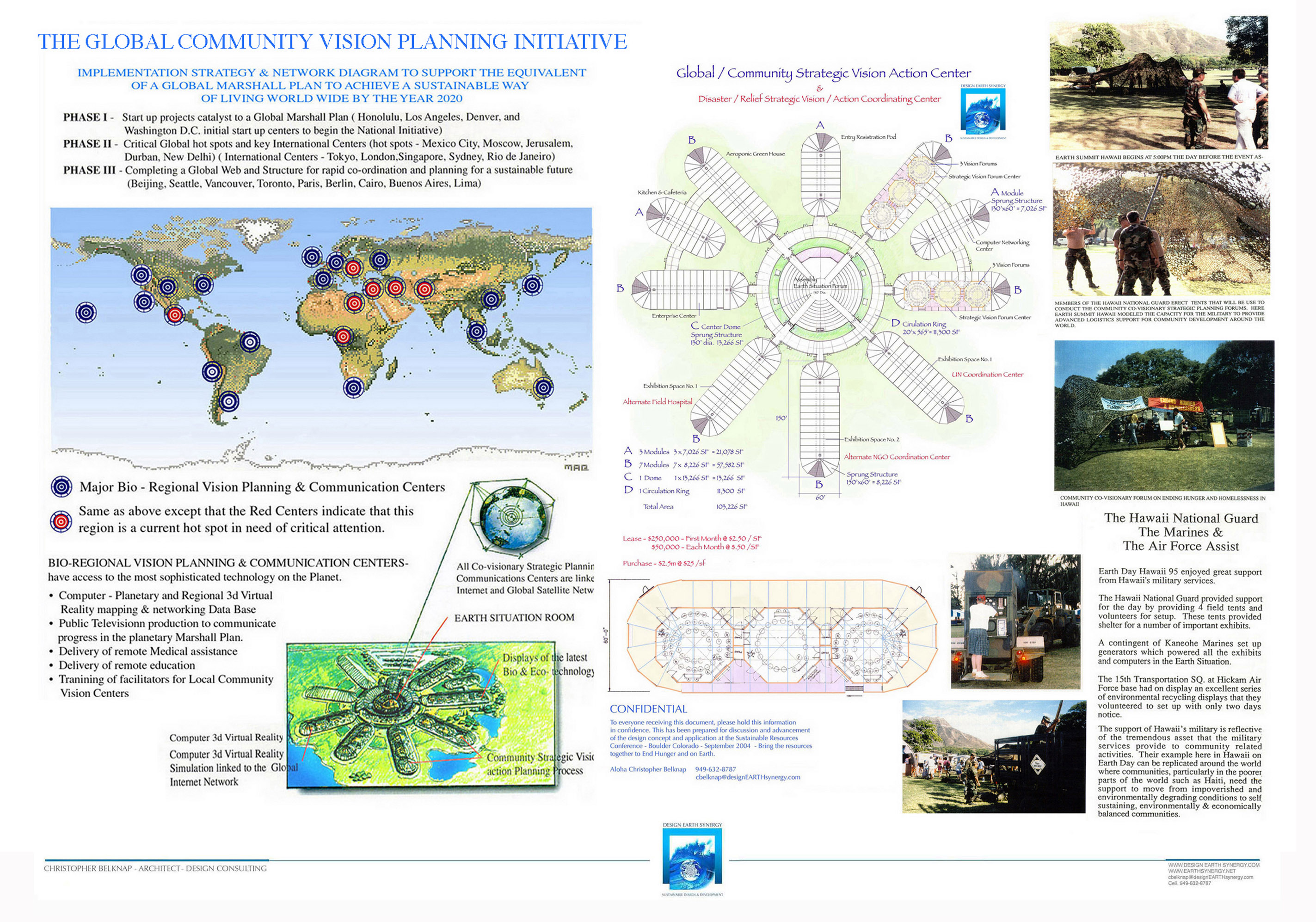
Video Telephones Connect Students from Around the World:
Three video telephones connected young people in Hawaii to youth around the world who were in a dialogue for action on Earth Day challenges. To model the Community Vision Center process, a series of Community Vision Forums were also set up to explore solutions to current issues related to a sustainable way of living in Hawaii.
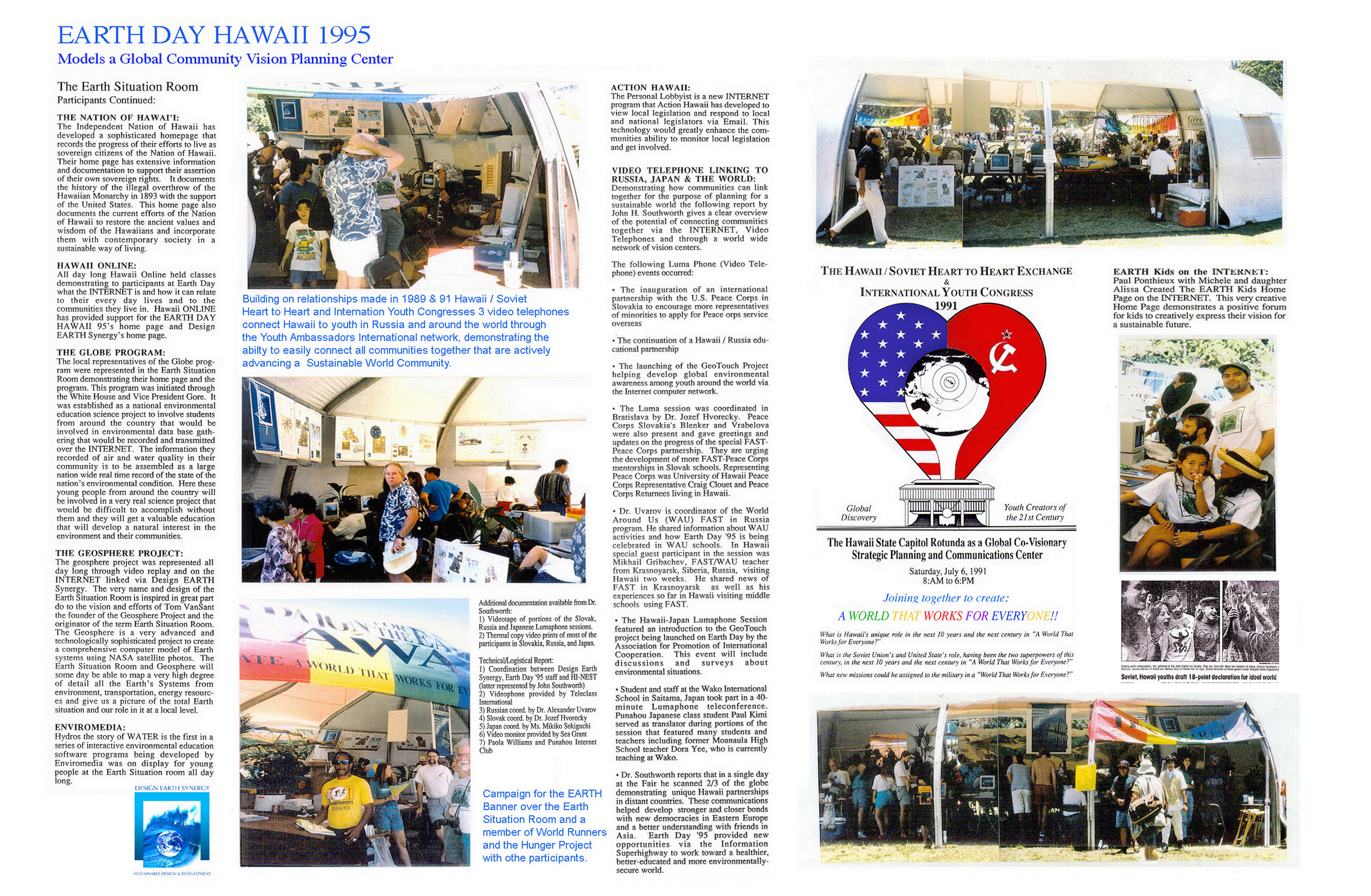
VISION CENTERS ESTABLISHED: Since the 1995 Earth Day event, there have been ongoing visioning efforts by community leaders in Hawaii who believe in the empowerment and consensus building value of this process.
Earth Day Hawaii drew 20,000 participants, during the course of the day, along with numerous government officials. One of the government officials was Mayor Jeremy Harris who viewed the full presentation and who, in subsequent years, established a Community Vision Center Network on Oahu that replicated the community vision center network structure presented. In 2003, the U.S. Conference of Mayors recognized Mayor Harris and the City of Honolulu with an Outstanding Achievement Award in the 2003 City Livability Awards Program for his leadership and the Community Vision Program his team established.
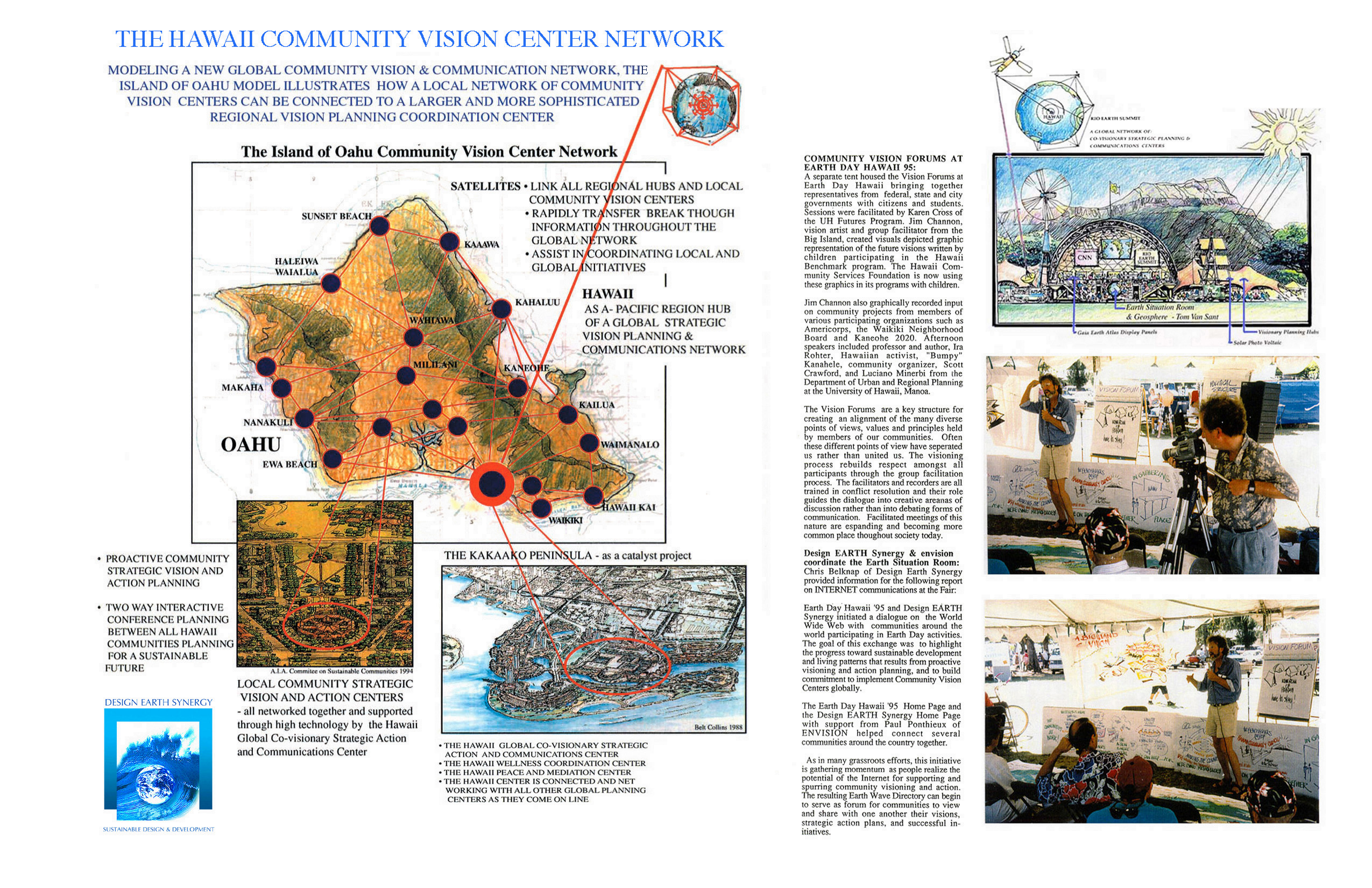
Diagram of Local Community Vision Center that can be setup in Communities Worldwide:
This activities diagram illustrates the various functions of a Local Community Vision Center. These centers can be located in Communities and Cities through out the United States and Communities in the Developed and Developing World Community. All Community Vision Centers can connect on the Internet and Social Media and share their Sustainable Community Vision and Action Plan for the next 1-5 even 10-15 years based on their resources and Cultural Preferences what their situation is at present and where the would like to be in their progress for a better community in the future based on a Timeline and achievable goals and objectives. This planning is achieved in the highly collaborative Community Vision Planning Process that encourages high participation by all members of a given community.
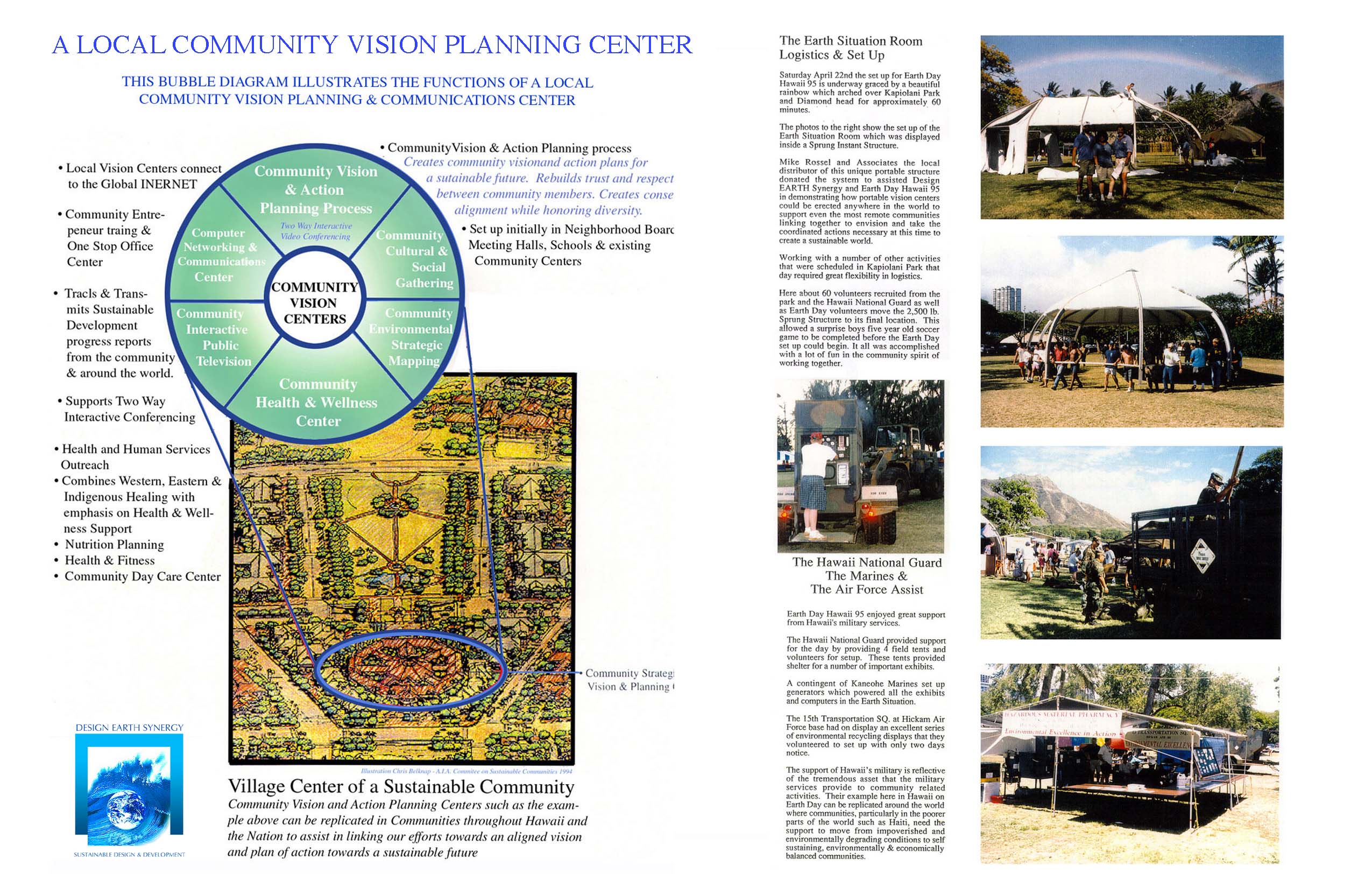
Design Synergy Group Acknowledgements Record:
The following is the Acknowledgement Record of various people and organizations that were inspirational sources that inspired Design Synergy Group, and others to take on these Initiatives in Hawaii. This is also a record of the many organizations and some of the key members of a relatively small core team of volunteers in Design Synergy Group and for the 1992 Hawaii Earth Summit – Earth Vision Foundation members that were at the center of the organizational team that was assembled for each Initiative in this record.
Click on Image to Expand:
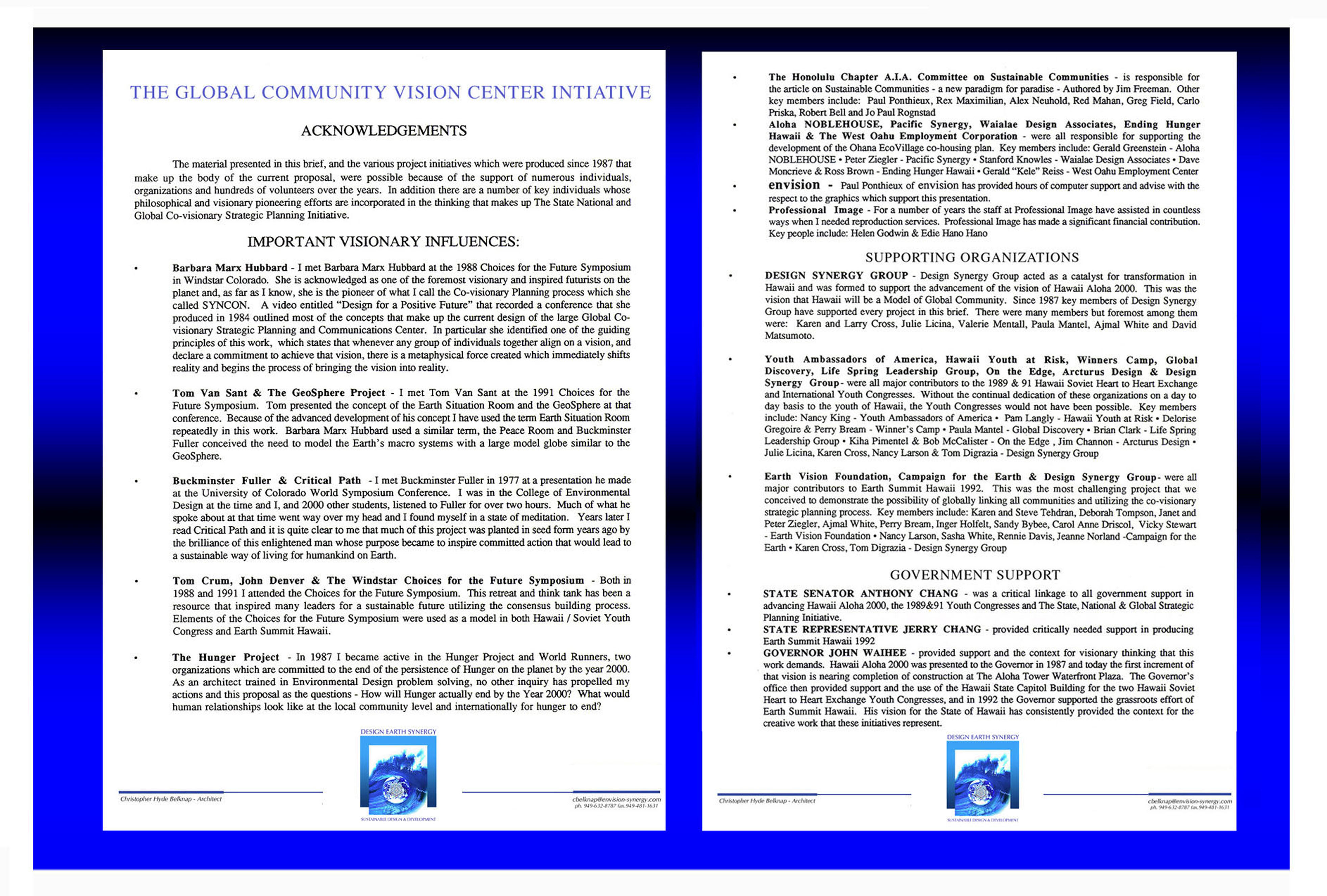
1992 – EARTH SUMMIT HAWAII – connects Hawaii to The Rio Earth Summit – United Nations Conference on Environment and Development, Rio de Janeiro, 3-14 June 1992:
Co-founded Earth Vision Foundation to produce “Earth Summit Hawaii”. This event connected Hawaii to The Rio Earth Summit. The Rio Summit, organized by the United Nations, was the largest coordinated effort by leaders from nations around the world who came together to address the issues and principles of sustainable development and cooperation at an International level. This gathering resulted in the United Nations document – Agenda 21, which laid out the principles for international cooperation, and a blueprint to achieve sustainable development into the 21st Century.
Note: Click on all images and Illustrations to Expand:
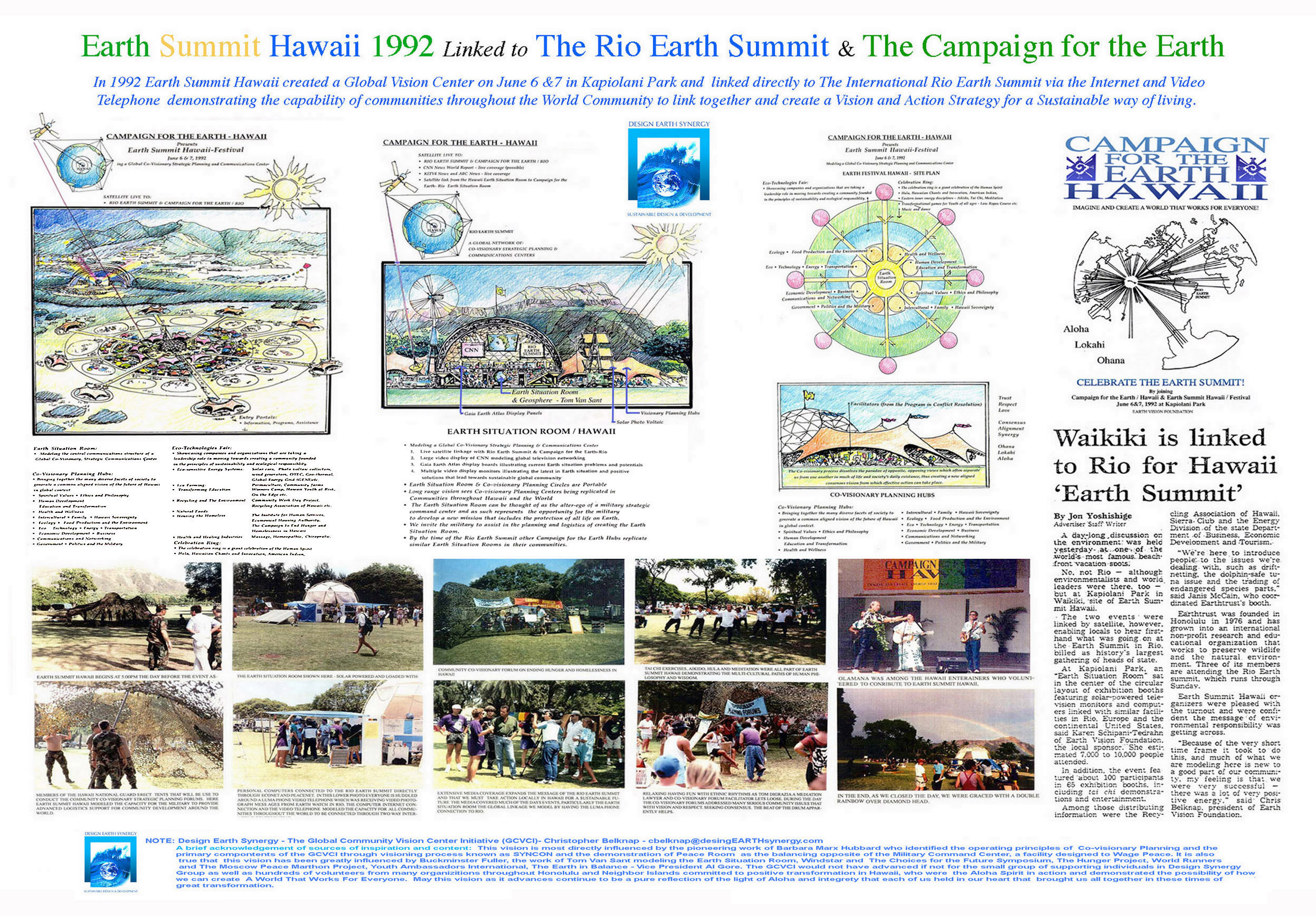
June 7,1992 Earth Summit Hawaii – Community Vision Center Demonstrated –
While the week long Rio Summit was underway, “Earth Summit Hawaii”, on June 7,1992, attracted approximately 5,000 people throughout the day. This event demonstrated how not only the World Leaders, but also millions of individuals at the local community level, could meet for the same purpose via the Internet and the “Earth Situation Room”.
At the local community level citizens were provided the forum to focus on sustainable development. They discussed their vision and plan to achieve a sustainable way of living and higher quality life in their local community. “Earth Summit Hawaii” demonstrated the Community Vision Center’s potential and the possibility of connecting all communities in the World together, via the then emerging Internet, for the purpose of developing their local plan for sustainable development. Those unique community plans from around the World begin to form a matrix of a positive global vision and plans for action – for a “A Sustainable Way of Living”.
Earth Situation Room Demonstrated –
During the event, an “Earth Situation Room” (a term used by Tom Van Sant founder of the “GeoSphere Project”), was erected in Kapiolani Park in Honolulu. The Earth Situation Room gives the community members a view into macro Earth issues such as Global Warming and deforestation, or reforestation in the case of progress being made to restore the environment.
Inside the demonstration Earth Situation Room, one computer was connected directly from Honolulu via the Internet to delegates from Hawaii attending the Earth Summit in Rio (Note: three years later, at “Earth Day Hawaii 1995” the Earth Situation Room expanded to 20 computers). Live reports were sent via email from Rio, with exchanges and comment returned from Hawaii. A video telephone was set up in Hawaii and a delegate with Earth Trust took another videophone to Rio. Live images were exchanged demonstrating the possibility of video conferencing between communities throughout the world, or a region.
Community Vision Forums –
were staged with creative discussions whose purpose was to develop solutions to Hawaii’s local issues relating to sustainable development. “Earth Summit Hawaii” was a major undertaking accomplished completely with volunteer help. It was achieved with the support of City of Honolulu and State of Hawaii representatives who passed supportive resolutions. Many thousands of people, including senior government officials, were introduced to the concept of the Community Vision Center.
Expand Images to view original concept layout drawings for Earth Summit Hawaii 1992 and to view photos of the actual Earth Summit Hawaii events on June 6 & 7 1992:
1989 – 1991 The Hawaii/Soviet Heart to Heart Exchange & International Youth Congress:
Design Synergy Group coordinated The Hawaii / Soviet Heart to Heat Exchange with Youth Ambassadors International, and designed two International Youth Congresses in 1989 and 1999 in The Hawaii State Capitol along with leaders from numerous community groups such as Winners Camp, On the Edge and many others active in the human potential movement in Honolulu in the 1980’s & 1990’s.
Eleven Soviet Youth Ambassadors from arrived in Honolulu from Moscow, with an organization called Children Creators of the 21st Century, founded by Dr. Evgeny Velikhov and his wife Raisa. Dr. Velikhov, at the time was Vice Chairman of the USSR Academy of Sciences, an adviser to Mikhail Gorbachev on Nuclear Affairs, and has held many distinguished positions since that time. The Soviet Youth Ambassadors joined 300 Hawaii Youth Ambassadors who came from each of the Hawaiian Islands and were members of an American organization called Youth Ambassadors International. Over the course of 7 days they had fun exploring Hawaii such as a trip to Haleakala on Maui, surfing and outrigger canoeing off Waikiki with World Champion Surfer and Hawaii State Representative Fred Hemmings. Then as a group the Hawaii and Soviet Youth Ambassadors explored their inner and outer limits of courage and integrity in a day long team building event called The Ropes Course facilitated by On The Edge.
The next day October 1st, they gathered in the Hawaii State Capital Building Rotunda, that was provided with assistance of State Senator Anthony Chang and Governor John Waihee, where they modeled the actions of a Global Vision Planning Center. Part of the all day event entailed playing Buckminster Fuller’s The World Game – that was a model of Global Population and distribution of resources and wealth, Earth Resources and Global Challenges, relating to the environment, energy resources, water, poverty & hunger challenges and the potential of Nuclear War. Then during the afternoon they conducted a Global Collaborative Visioning Planning exercise where the American and Soviet Youth Ambassadors developed a vision and wrote a formal declaration of values that would be present in “A World that Would Work For Everyone”. This came out of three vision forums that focused on “Global National Relations and Communications”, “Global Economics and the Environment”, and the “Military and Governments in a World beyond War”.
Click on Images and Illustrations to Expand:

Expand Images of Hawaii / Soviet Youth Congress 1989 & 1991
The Moscow Peace Marathon – World Runners – The Choices for the Future Symposium:
For three consecutive years, Christopher Belknap volunteered with World Runners and a delegation of 11 World Runners from Hawaii, who were part of a larger American World Runners Team (approx. 150 in 1987), who along with a number of Europeans World Runners, ran in the Moscow Peace Marathon in Russia in 1987,1988,1989. Each consecutive year the team expanded to approximately 350 in 1989.
The members of World Runners were citizen ambassadors whose purpose was to promote understanding and Peace between The United States and The Soviet Union, and for the vision that saw the potential of the two main Cold War advisaries working together for the “End of Hunger by the Year 2000”. These three years from 1987 to 1989 were a time of rapid transformation from the previous 40 years of Cold War between the United States, Europe, NATO and The Soviet Union culminating with the Fall of the Berlin War and The Dissolution of Soviet Union. With the end of the Cold War there was an opening for a new Peace and the possibility of far greater international cooperation working together on many fronts, including the underlying issues that produce persistent Hunger in the World. For a period of time from the early 1990’s to late 1990’s, the World Community did begin a process to deescalate many long standing confrontation points around the World, and Nations came together in a series of international conferences including The Rio Earth Summit in 1992 and International Conferences on Human Rights to begin to address comprehensively the issues of the Environment, Development, International Human Rights, and to move together towards developing policies between Nations that could eventually lead to a Sustainable World Community- including a World without Hunger.
Through this participation in Moscow Peace Marathon Project, Chris Belknap made numerous connections that led to being asked to coordinate two Hawaii Soviet Heart to Heart Exchanges and The Hawaii / Soviet Youth Congresses in 1989 & 1991. On the return from Moscow in 1988, he attended “The Choices for the Future Symposium” organized by popular country singer and activist, John Denver and Aikido and Conflict Resolution Master, Tom Crum of The Windstar Institute in Aspen, Colorado. At this event, Chris met visionary/futurist, Barbara Marx Hubbard and learned about her pioneering consensus building visioning structure called SYNCON. The principles that Barbara Marx Hubbard articulated in her presentation, “Design for a Positive Future”, are at the core of the Community Vision Center process and design concepts recorded in this presentation and it was the template for the consensus building Visioning Process in the two World Youth Congresses.
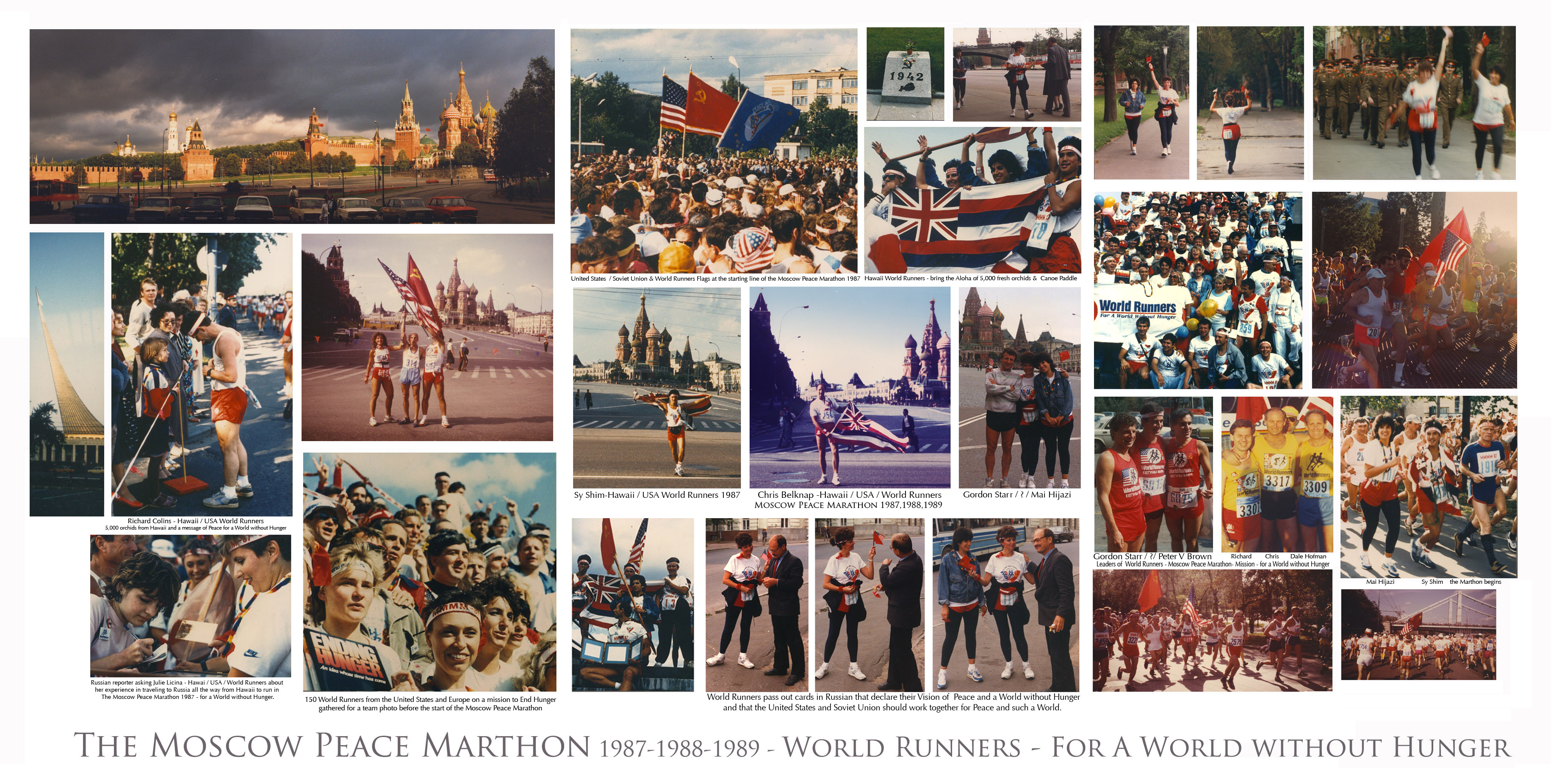
1985 -1987 Hawaii Aloha 2000 – Vision Plan for a Sustainable Hawaiian Islands – Presented to Governor John Waihee – July 1987
Written in 1985, “Hawaii Aloha 2000” was a visionary paper and initiative that advanced the idea of Hawaii becoming a model of sustainable community in the Pacific. This document focused on an initial seed project, the Redevelopment of Honolulu’s waterfront as a focal point for Downtown Honolulu, that would be a catalyst to bring people together working from a consensus built vision. The illustrations and paper pointed to a series of ideas for Honolulu’s waterfront that would create a clear focus and gathering center to Downtown Honolulu that would be the “Cultural Heart of the City”. This would be the first component of a larger State Master Plan. After a year of networking, presentations to community groups, leaders and stake holders, as well articles published in the major newspapers The Hawaii Aloha 2000 vision plan was presented in July 1987 to Governor John Waihee. Design Synergy Group recommended to the Governor that the State could sponsor a design charrette made up of volunteer local architects and planners to develop a series of consensus built vision plan alternatives for Honolulu’s Waterfront District and seek participation and input from all interested community members.
Click on Images and Illustrations to Expand:
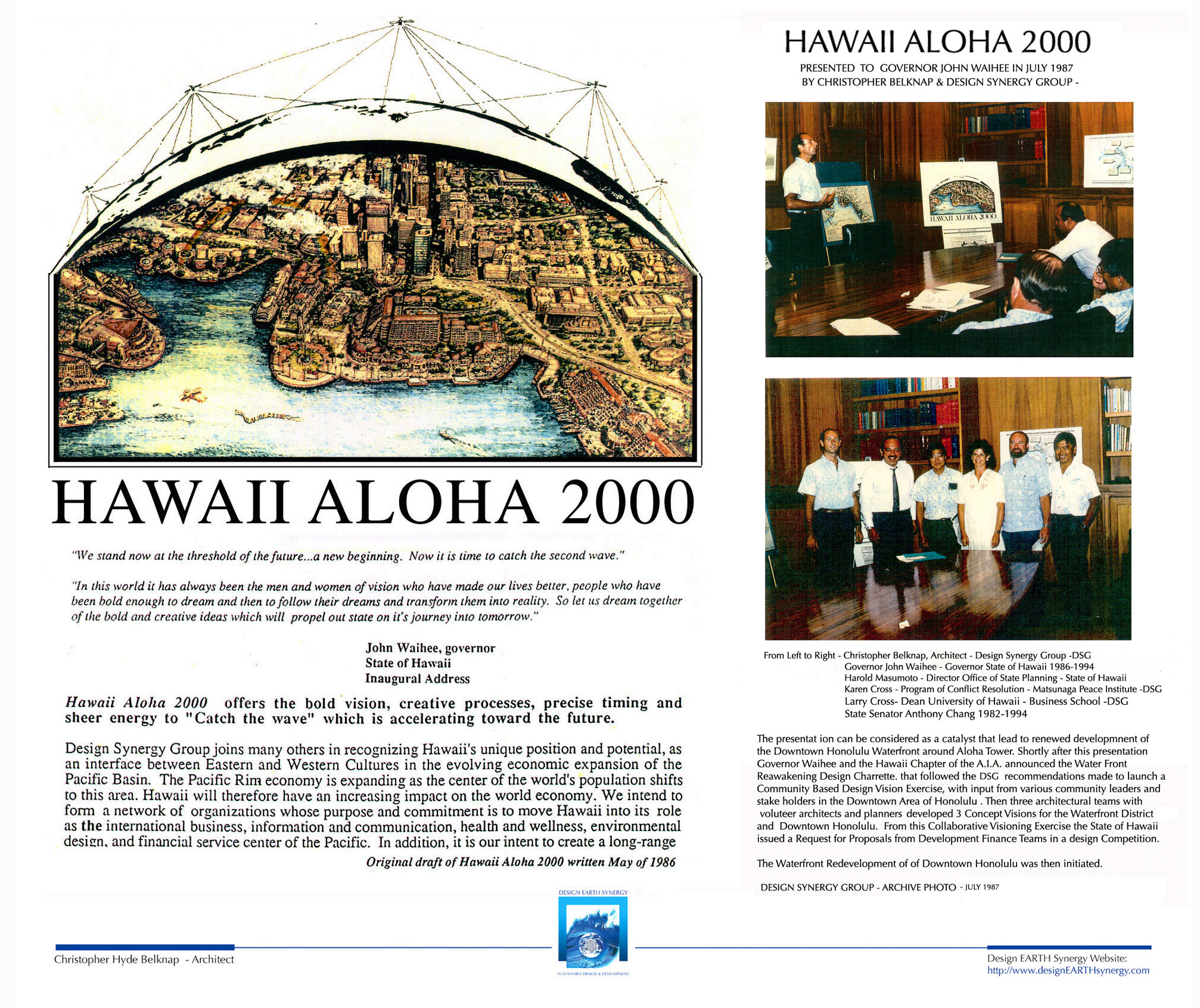
August 1987 – Governor Waihee announces the Waterfront Reawakening Design Charrette –
Within a month after our presentation to Governor Waihee of “Hawaii Aloha 2000”, the Governor and the Hawaii Chapter of the AIA initiated, in August 1987, “The Waterfront Reawakening Design Charette” The resulting consensus built vision led to the development of the Aloha Tower Market Place and other development projects, which continue today.
Expand Images of Articles Published and Presentations made leading up to The Waterfront Reawakening Design Charette – View Excepts from the Charette Report and Articles Published after the Charette.
“Hawaii Aloha 2000” – a Model for Sustainable Development –
The Hawaii Aloha 2000 Vision Plan went further to describe a vision and purpose for each island that would provide a central theme consistent with Hawaii being a model of sustainable development. Central to this description was the idea of Hawaii being one of the major Bio-Regional Vision Centers in the center of the Pacific. Since the original writing and subsequent extensive networking by Design Synergy Group, a number of the elements of the original “Hawaii Aloha 2000” paper are reality today.
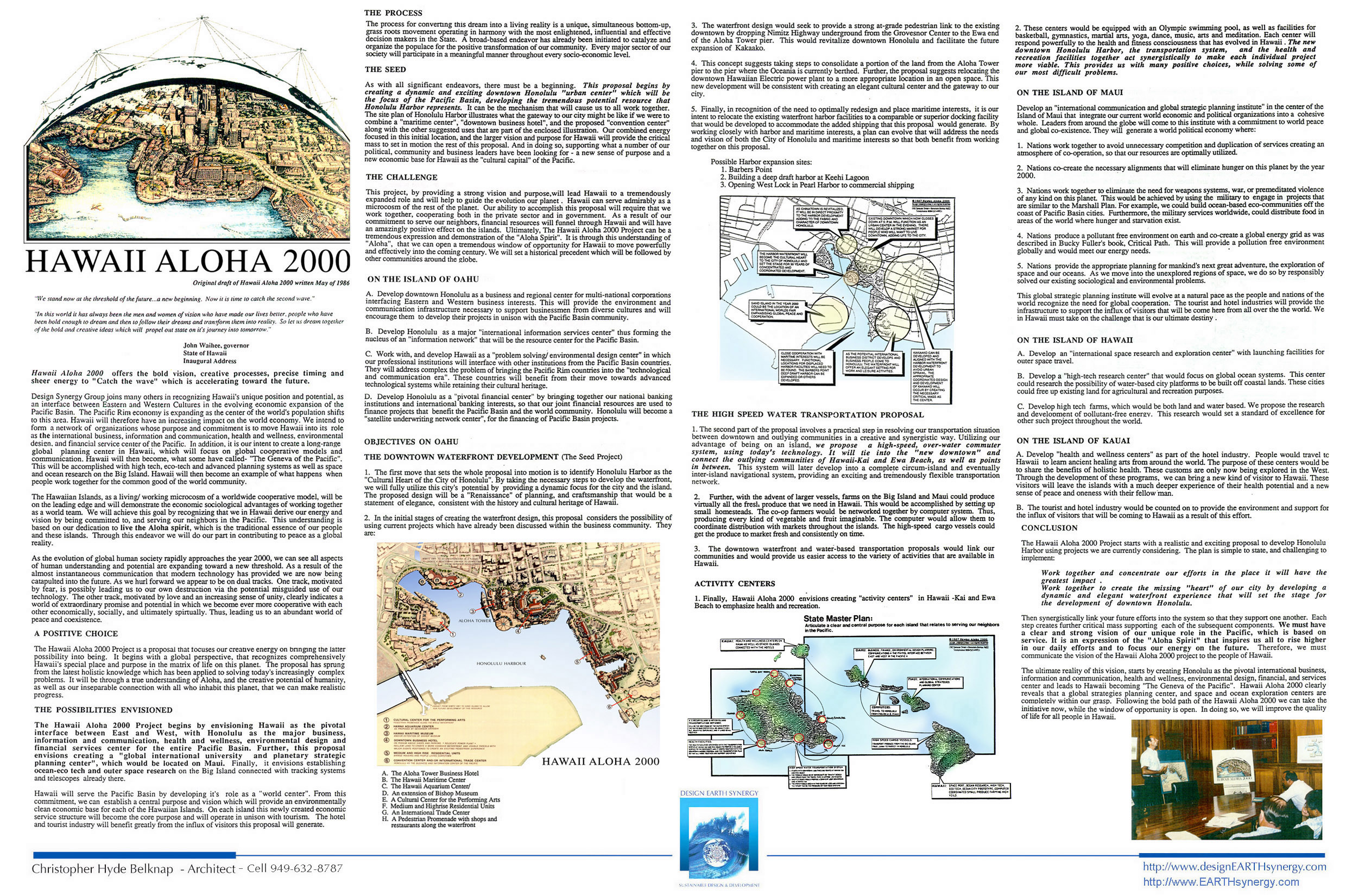
Click on Images to Expand Hawaii Aloha 2000 Text:
1986 – 1996 DESIGN SYNERGY GROUP
This organization was formed to advance the ideas and vision contained in “Hawaii Aloha 2000” That Hawaii could be a model of Global Sustainable Community in the Pacific. Over the next 10 years members of Design Synergy Group were at the core of the design and coordinating process of the above initiatives and events.
Expand Image.
